Hello friends! This week is all new items – so, get ready! There’s a lot, I think they’re all lovely to look at and have really interesting generators, and they fill in a lot of gaps and add a lot of new mechanics as well, so without further ado:
First, some of the items demanded by some potential generated religions did not presently exist in the game, and this needed resolving. Specifically, there are a number of requests that would ask for a thumb from a slain or almost-slain foe (rather grisly, I admit); one that asks for the remains of a saint or a fallen warrior or priest who fell in a distant land, and I decided that might take several forms (thumb, skull, or heart); and one option that asks for proof that you have destroyed an altar of a rival religion. So, we now have a number of new items to address these needs. Firstly, when you manage to destroy an altar (with a pickaxe) it’ll drop a “Shard of an Altar” item, which is naturally itself generated and has a unique graphic depending on type of altar being destroyed. For example, here is an animal-god altar, and the shard I got from destroying it…
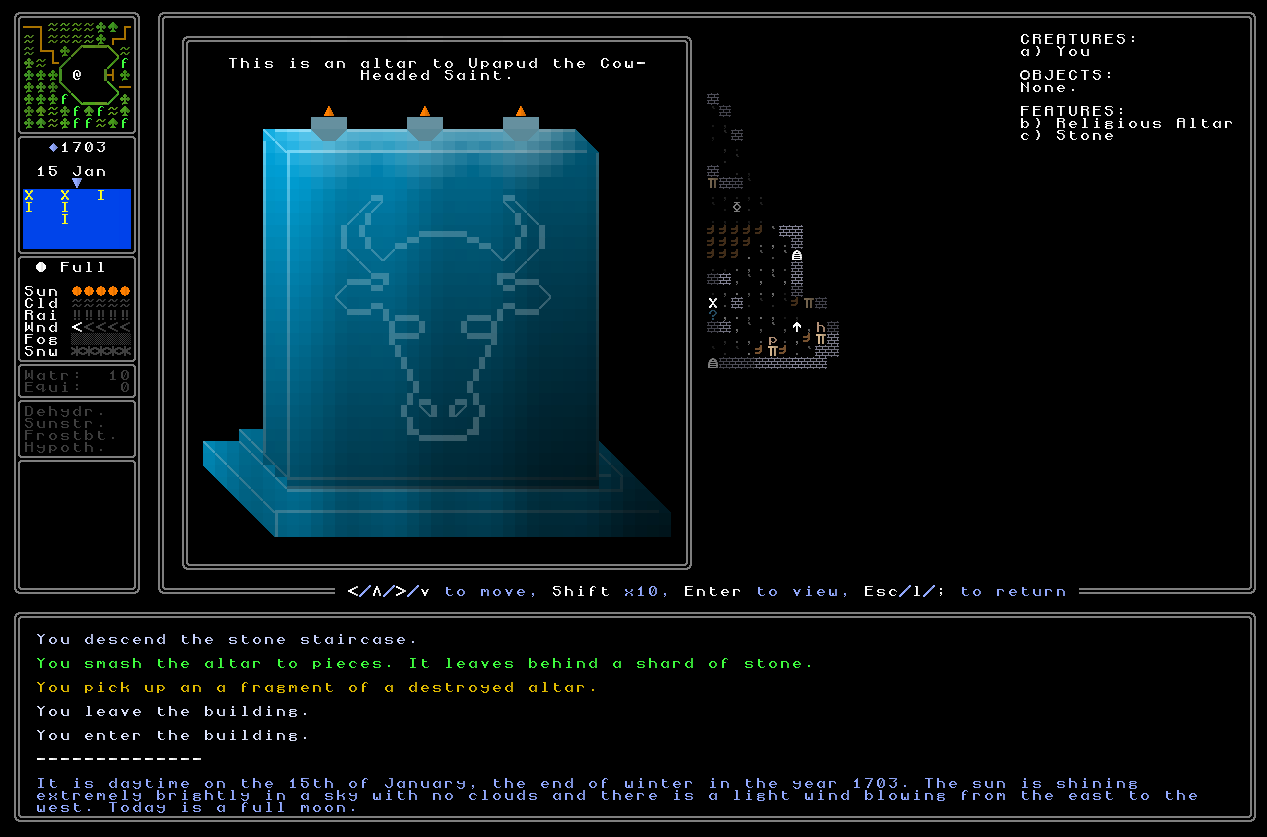
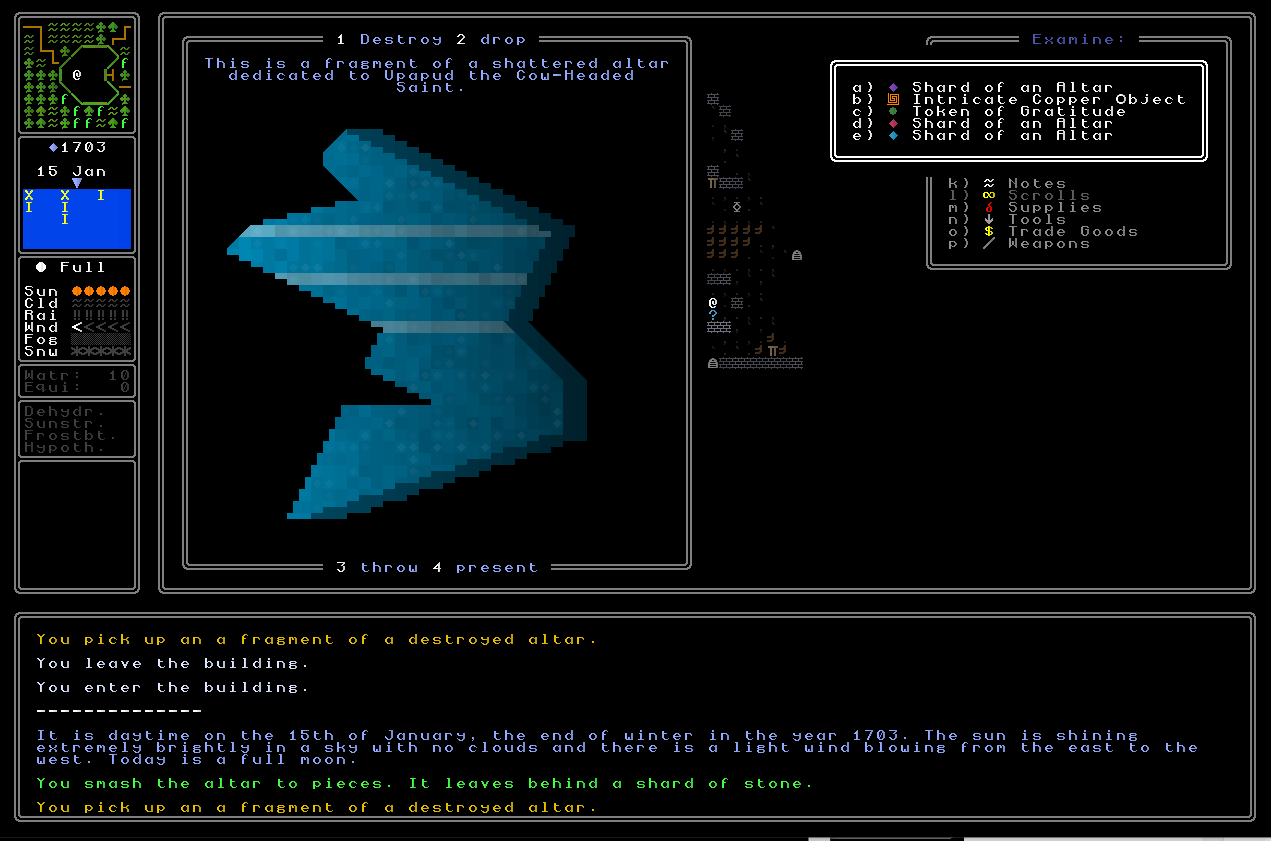
And here a “normal” type altar, with the shard I got from destroying it:
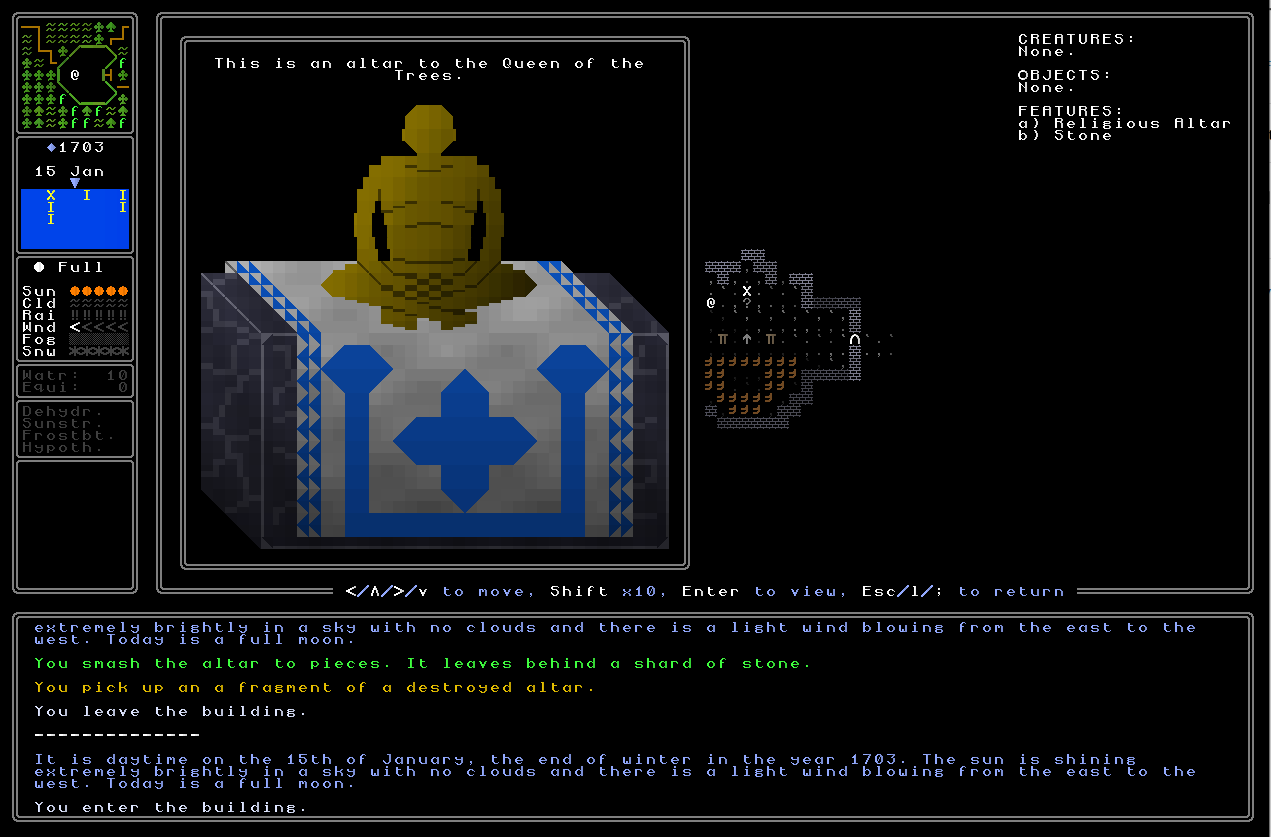
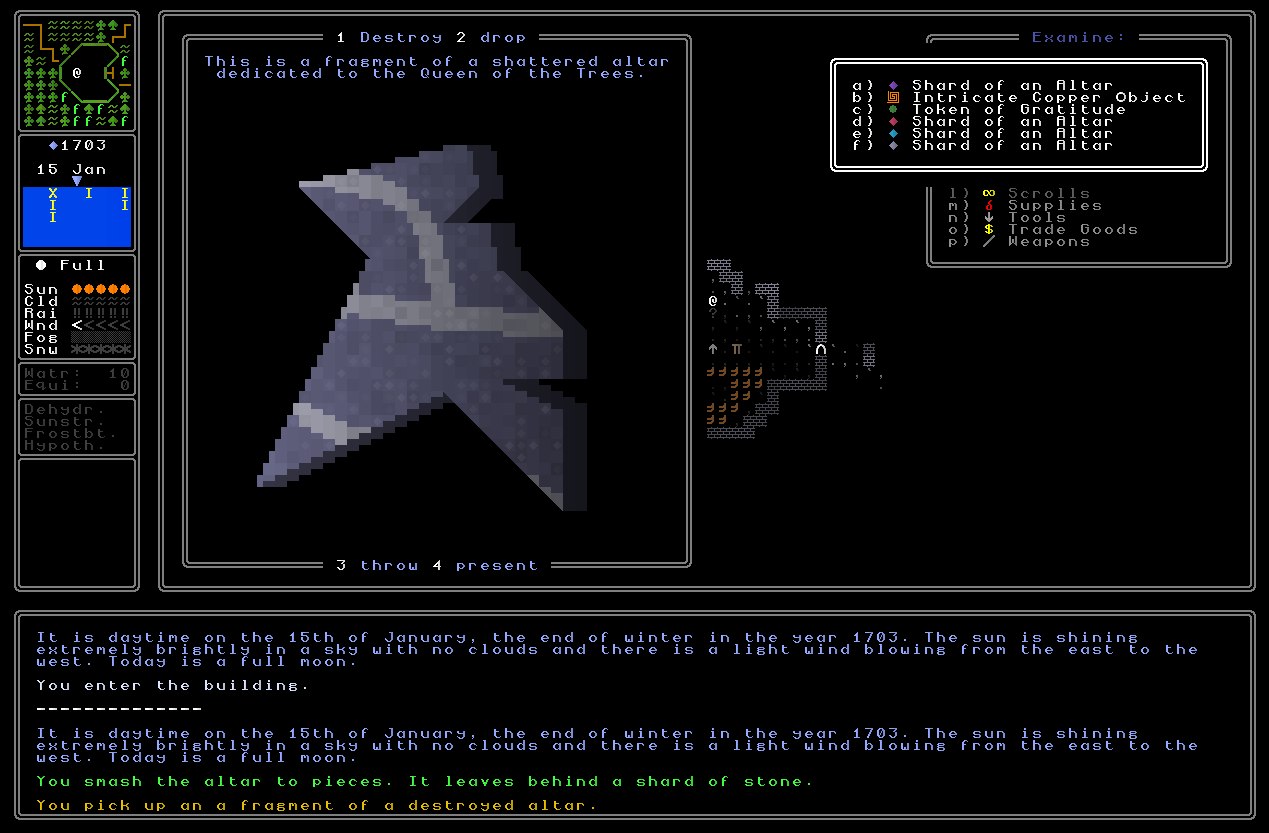
And a Lovecraftian one:
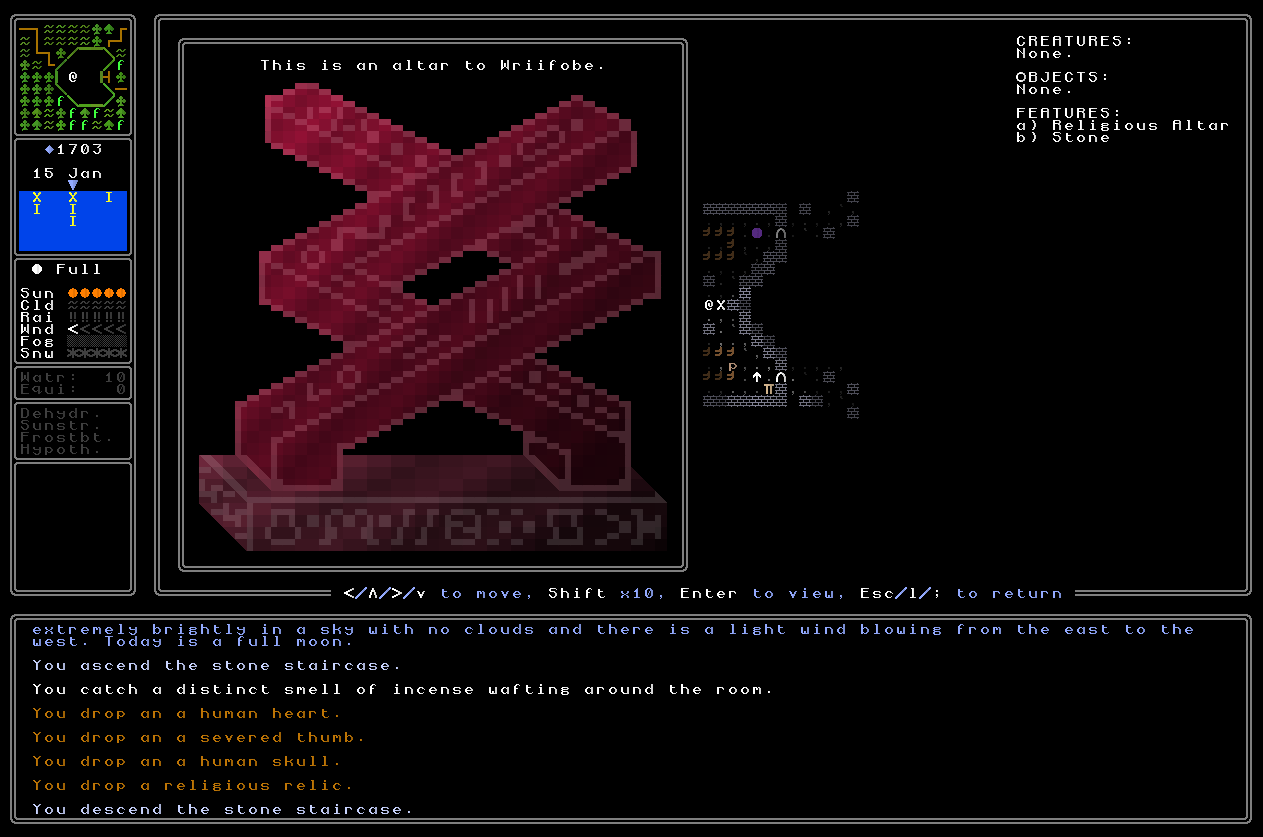
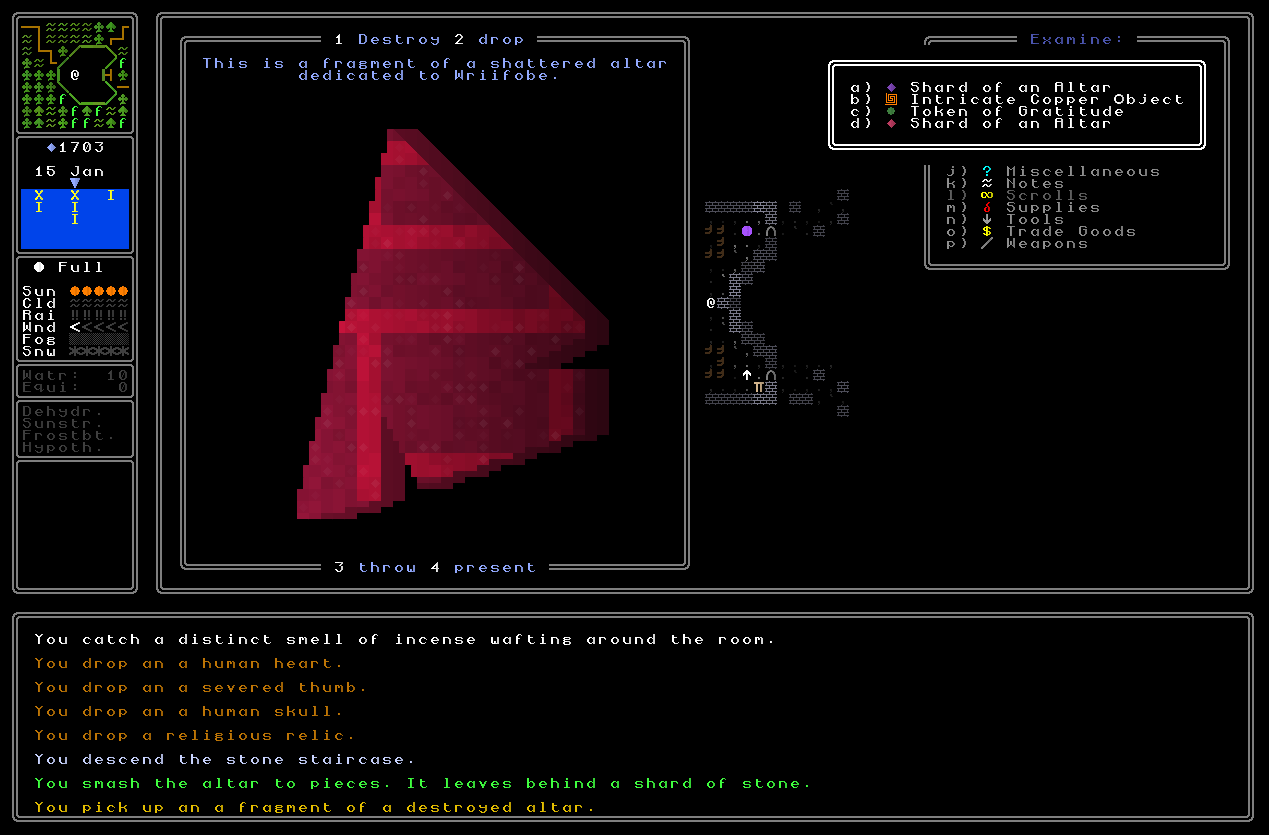
And so on. You’ll note that the colours always match, as do the patterns, at least to a very reasonable extent! I estimate that this generator can produce around 200,000 possible altar shards. These can be picked up, and these are the items you then return to the religion that wants altar destruction in order to prove you’ve done what they were after. Naturally, though, in the near future, just going into someone’s religious building – perhaps containing a priest, and twenty other people – and smashing their altar to pieces might not elicit a wholly positive response (though right now nobody minds – this is going to be in 0.12, the combat release). More generally though, I’m perfectly happy with some potential religion requirements being easier, and some being harder – that’s a key part of making them interesting elements of the game world that require thought as to whether this religion, or that religion, is the one to climb up the greasy pole with. Or, indeed, several.
Next on this list we then have thumbs, skulls, and hearts. Each of these now has its own generator and these were a lot of fun to make. Naturally these items aren’t only relevant to religions, but will be very relevant to combat later on, and all of them might be found as trophies, or taken as offerings, or anything else – either way, I think we can agree a bit of gore never hurt anyone! So here are some examples, and I have to say, I think all three of these generators – there are thousands of possible fingers, tens of thousands of possible hearts, and millions of possible skulls – are absolute winners:
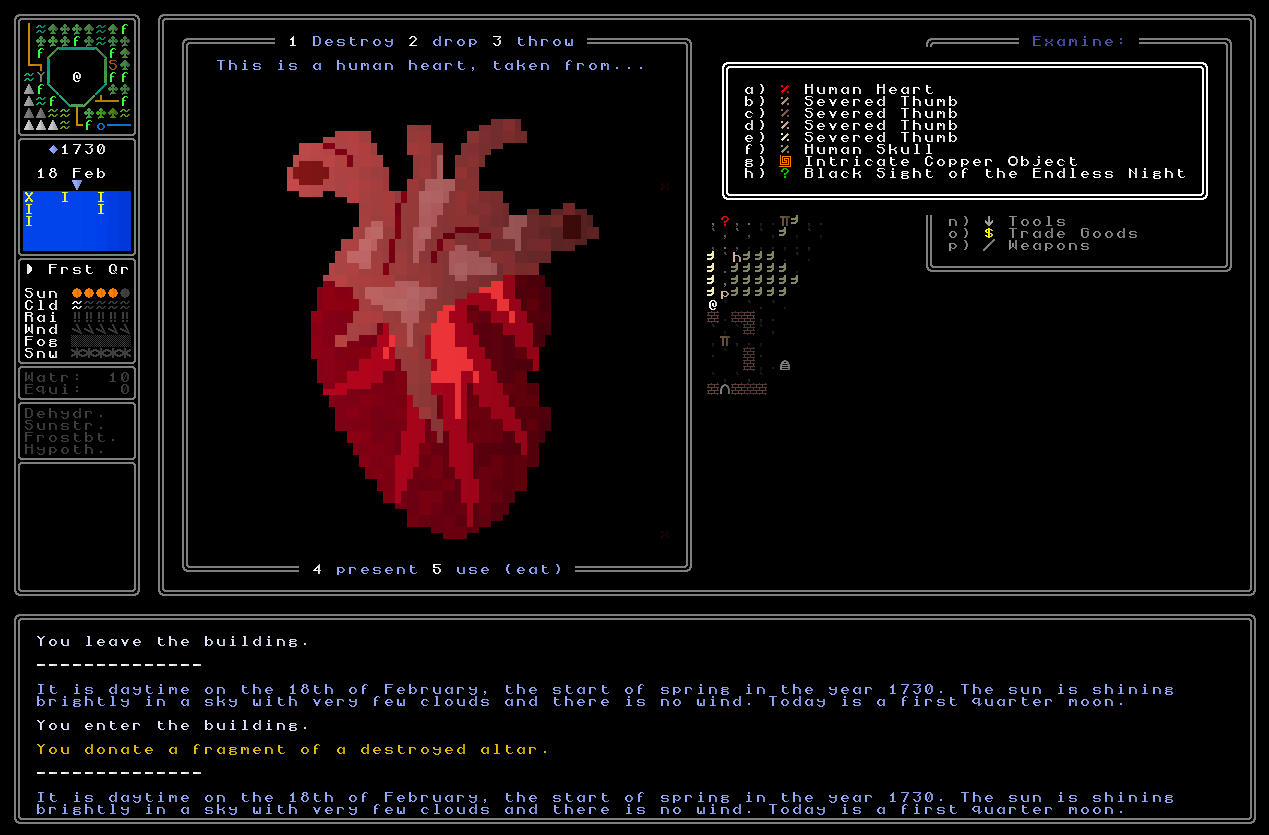
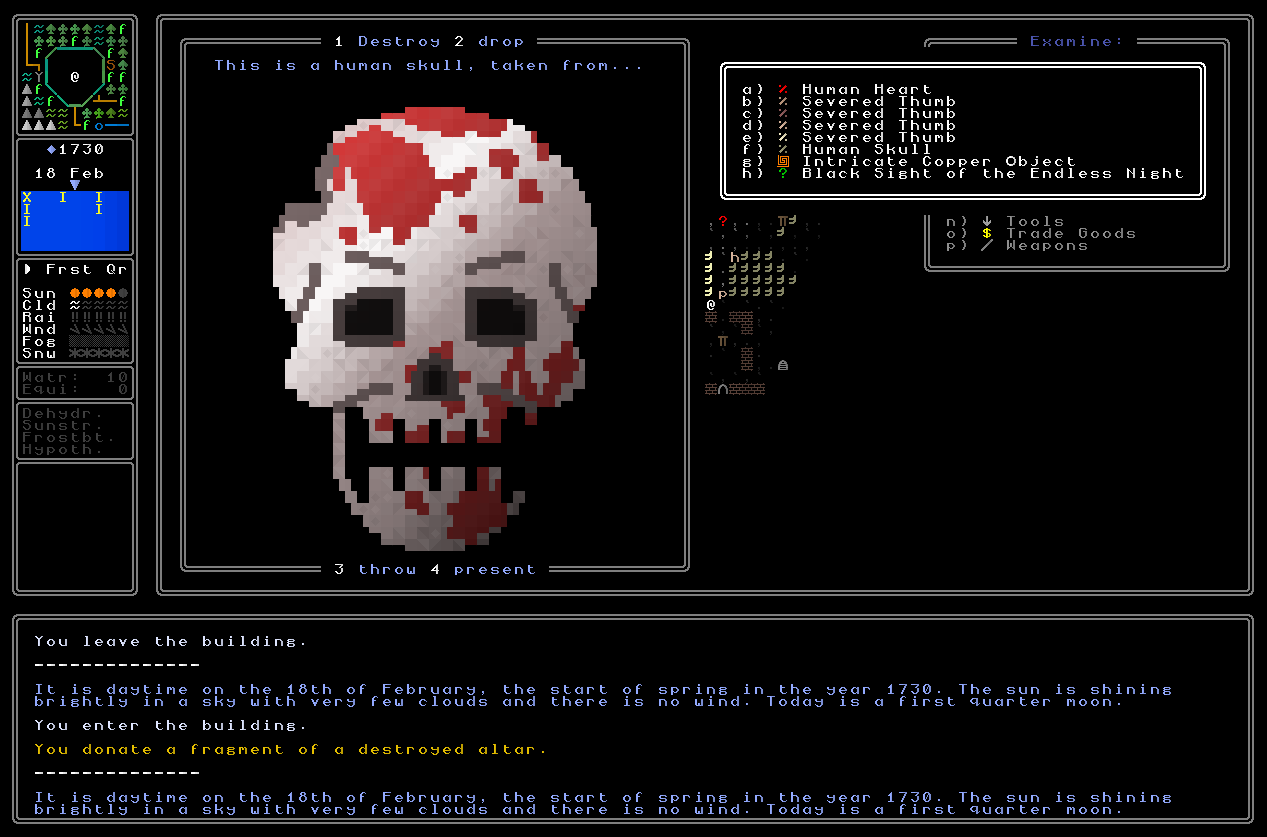
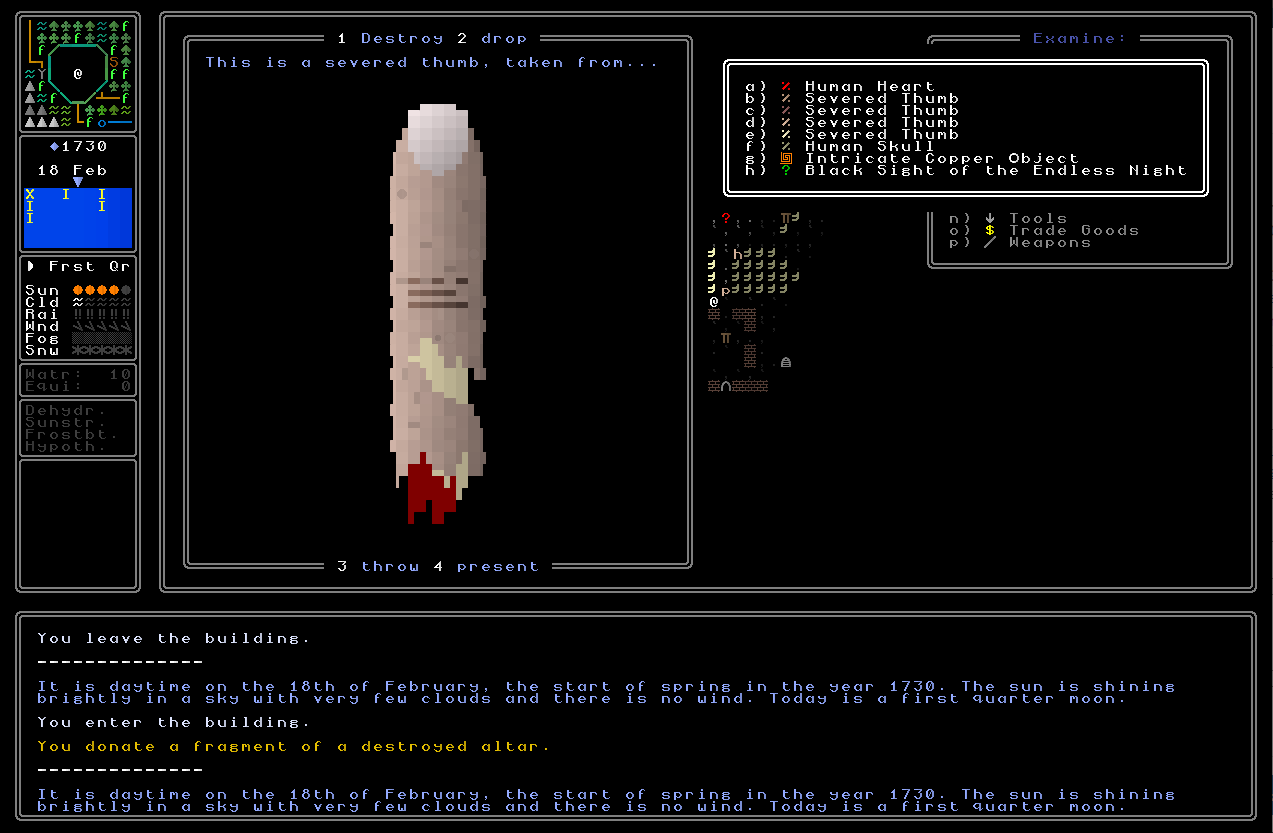
You’ll see the “taken from…” part trails off, as that’s where the game will soon tell you where you get it from, whether you found it on a corpse or a battlefield or a tomb or whatever, or whether it was from an enemy you slew in combat. The thumb graphic is of course based on the skin tone of the previous, er, owner (??), while skulls and hearts are just randomly generated without recourse to their previous owner. These all go in the “Miscellaneous Items” inventory, along with things like relics, relic shards, chests, and – obviously – anything else that doesn’t really fit into the other inventory categories. I anticipate this inventory actually being one of the smallest, as these are generally pretty obscure items and I don’t anticipate one ever collecting a large number at once… although, I mean, if you want to fill your room with the bloodied hearts of your fallen enemies, then frankly, who I am to stop you?
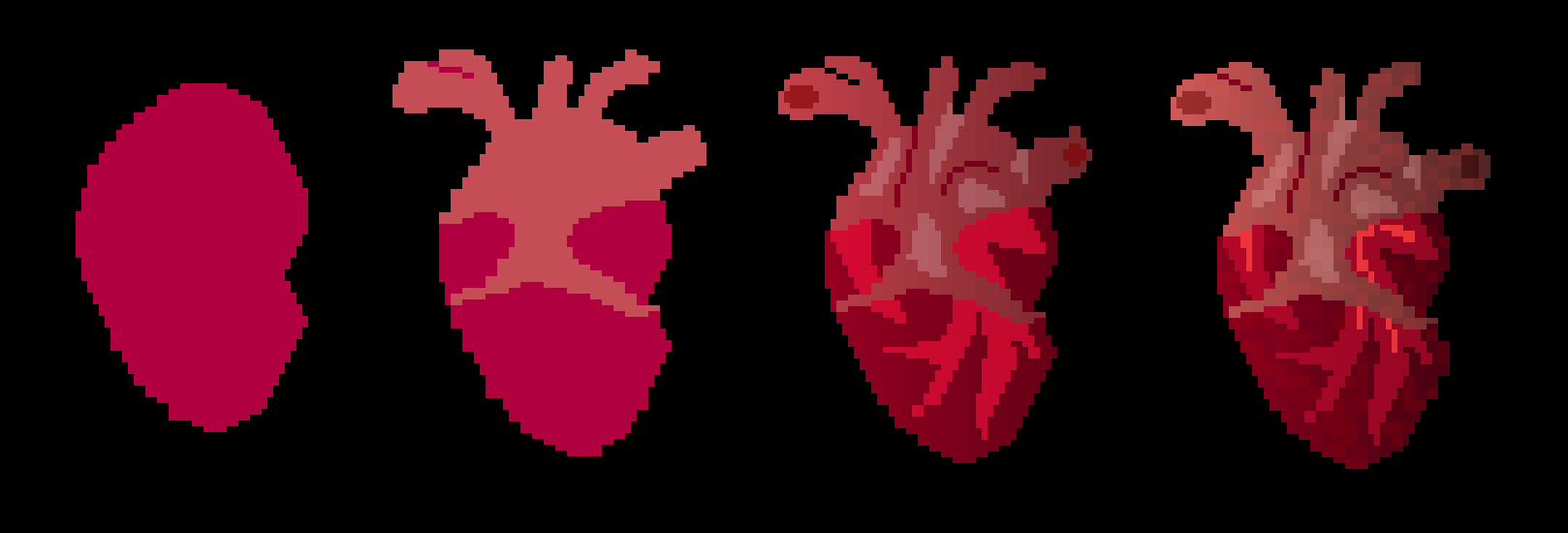
Finally, as part of these missing items I’ve also added in the “token of gratitude” item, which you’ll be able to get for showing mercy to a defeated enemy. I rarely talk about failed attempts at things, so here’s an interesting example I’ll just share with you all. My first idea was that upon offering mercy to a defeated foe, you’d get a little message in which they pick up a pebble and smear a streak of blood on it, and then you get that item. I had thought quite a while about what this item should be, as it had to be something generic that any character could give you when defeated in battle, and this is what I came up with – a little idiosyncratic, but I thought it worked quite nicely. I made a small and simple generator, and it came out with something I just didn’t think was all that impressive, and it wasn’t a sort of interesting or charming distinctive item. So I went back to the drawing board, again thinking – what is something every character will have on them, or can instantly create, to give the player as thanks for showing mercy – and I decided on the idea of buttons. Upon defeat and being shown mercy, an NPC could pluck a button off their clothing and give it to you as a token of gratitude. With this idea in mind I sketched something out, and loved what the generator produced, and then after some more work, I added variations for all the various shape preferences, and added colour variation depending on how swanky the clothing is that someone takes the button from, and we came out with this!
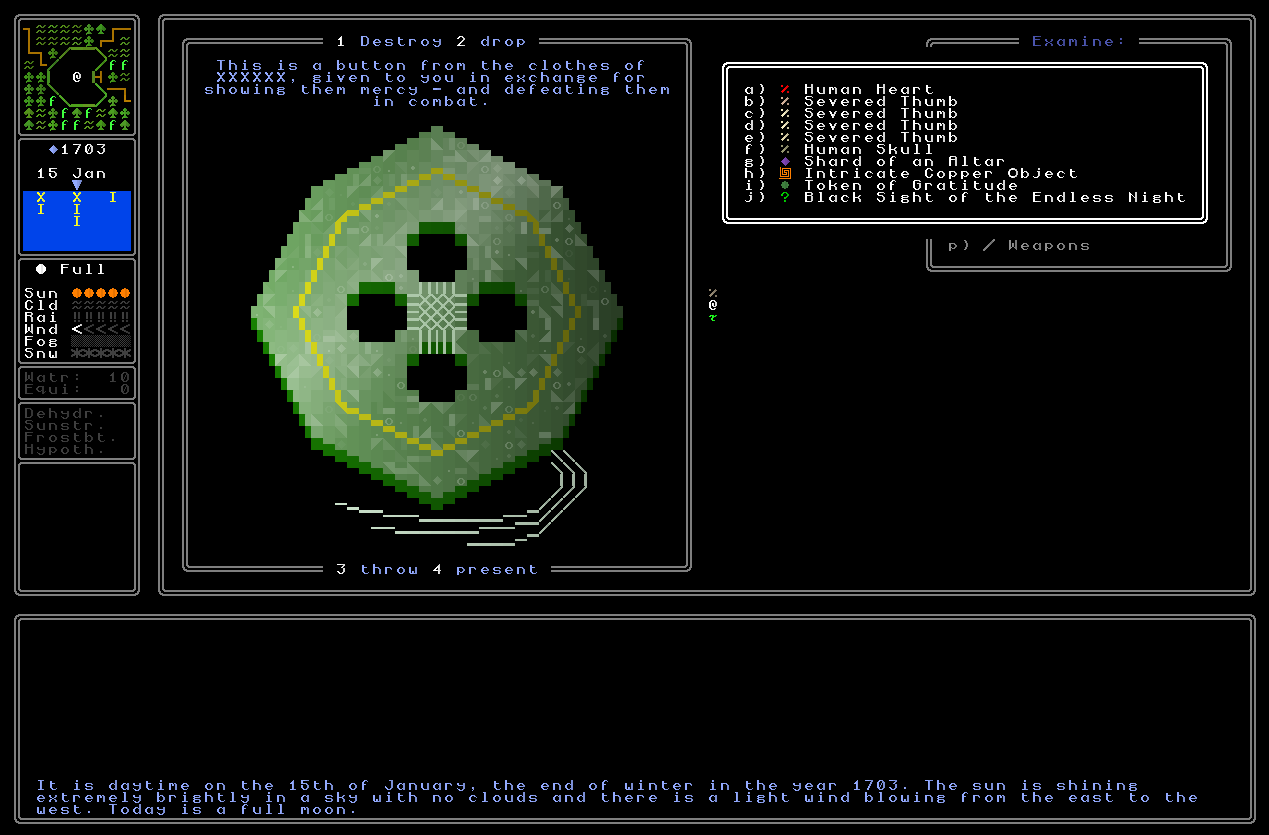
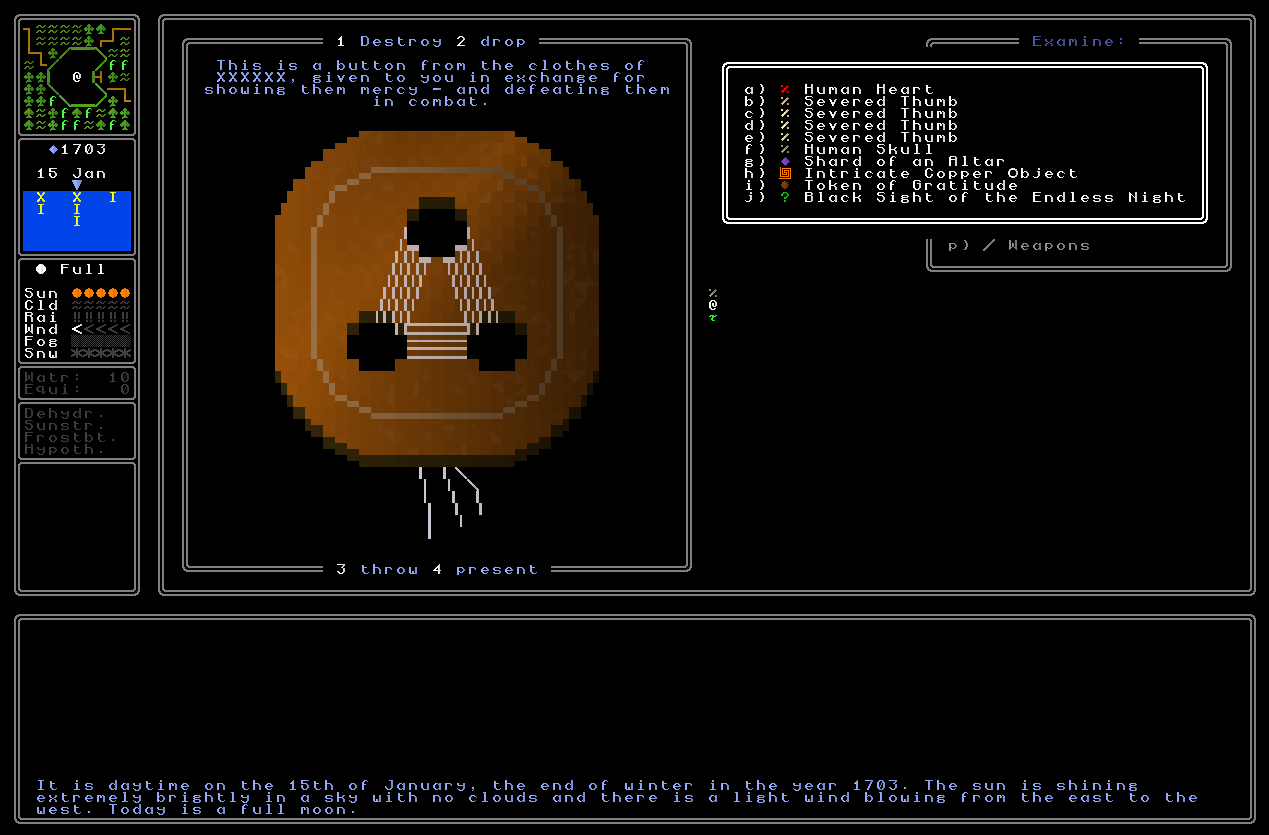
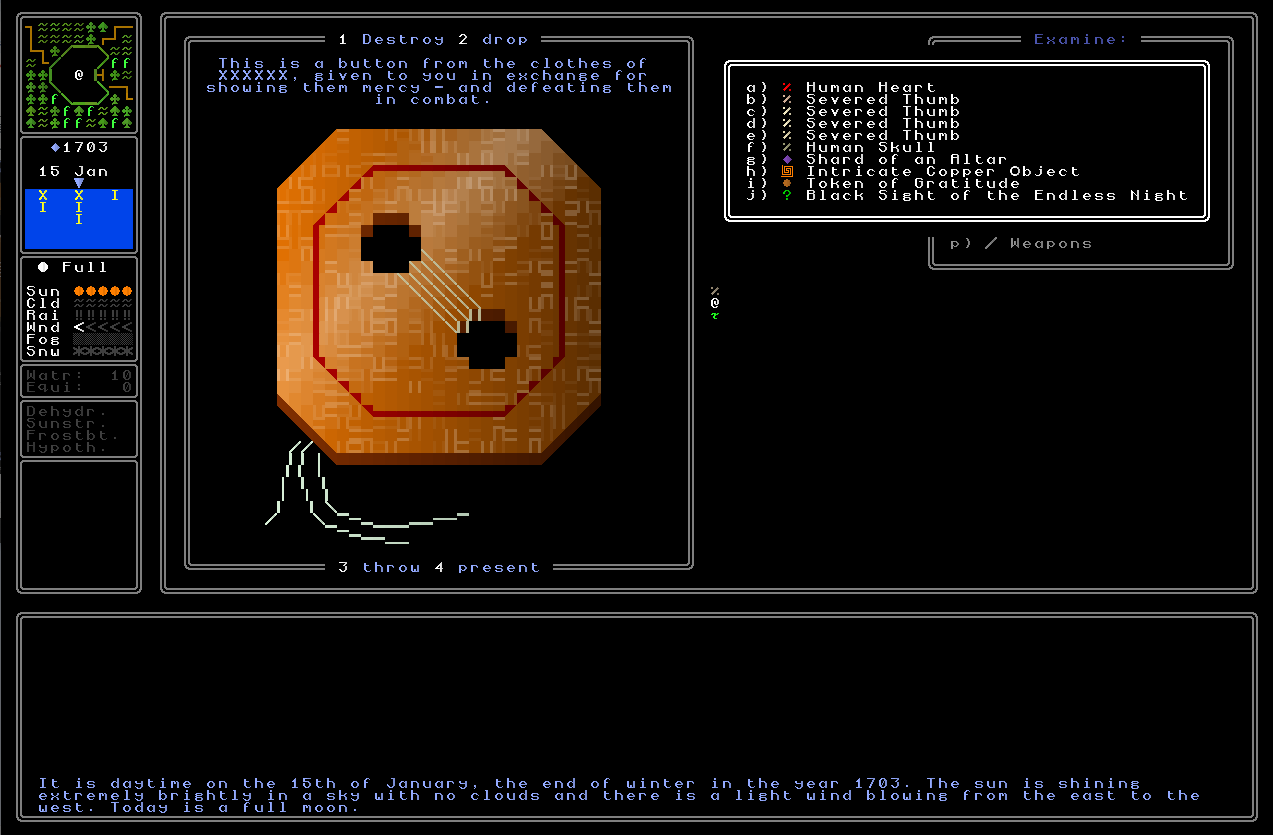
I have to say, I really like these. It’s still idiosyncratic, but honestly: I think it works. They vary a lot based on whether they are coming from high, medium, or low quality clothing, and based on the colour scheme that a particular culture uses, and the shape preference of that culture, and they also vary a lot from feudal, nomadic, and tribal nations (though I’ll go back and work on the tribal ones even more when the time comes to make these civilizations a lot more interesting) – by my count there are around a million possible buttons in this generator (a niche brag, but a good one0. And, also, just on a purely visual level the items are quite distinct from anything else in the game, which I think is really important and something I always aim to hit whenever I’m building a new generator. So yes, these are the “tokens of gratitude” someone can give you for showing mercy after a duel, and for now the only use will be that it’s one of the possible items a religion might want… but it’s always good to have a multiplicity of uses for the same thing, so maybe a token of gratitude will have financial value if it came from someone famous?
Or perhaps a private individual out there in the world collects them?
Or perhaps showing them to certain people (using the new “show” command, of course) might elicit certain responses?
Or maybe they can be used to taunt allies of a defeated foe?
Or maybe they can be used to impress others as to your martial prowess, your generosity, or both?
Or…?
Next, we come to scrolls!! I’ve been excited to generate these for a while, and I have to say I’m incredibly happy with how they’ve come out. These are the equivalent of books for nomadic civilization, and I wanted to make them really different from what we’d previously seen in books and really highlight the sense of a very different writing culture and style, as well as perhaps strong differences in what sorts of things are recorded, and how they are recorded and shared. My initial attempts to generate these were actually quite tricky, as I didn’t like some of the early drafts I came out with – horizontal scrolls looked far to scrunched up and I couldn’t find the room to make them meaningfully vary with the generator, but vertical scrolls just looked strange and a little weird. So, instead, I went with the idea of having two possible diagonal choices for scrolls, and this actually came out fantastically. Then I added a bunch of variation in terms of how the handles on the scroll at each end look, added some colour variation for scrolls of different qualities (and some nice “bands” on the outside of the paper for the medium- and high-quality variations), and then slapped on some seals in the middle (always bang-on centre for high-quality scrolls, sometimes a little off-centre for the others), containing both a relevant symbol and a randomly-selected pattern for the seal itself to have, and voilà, we have this:
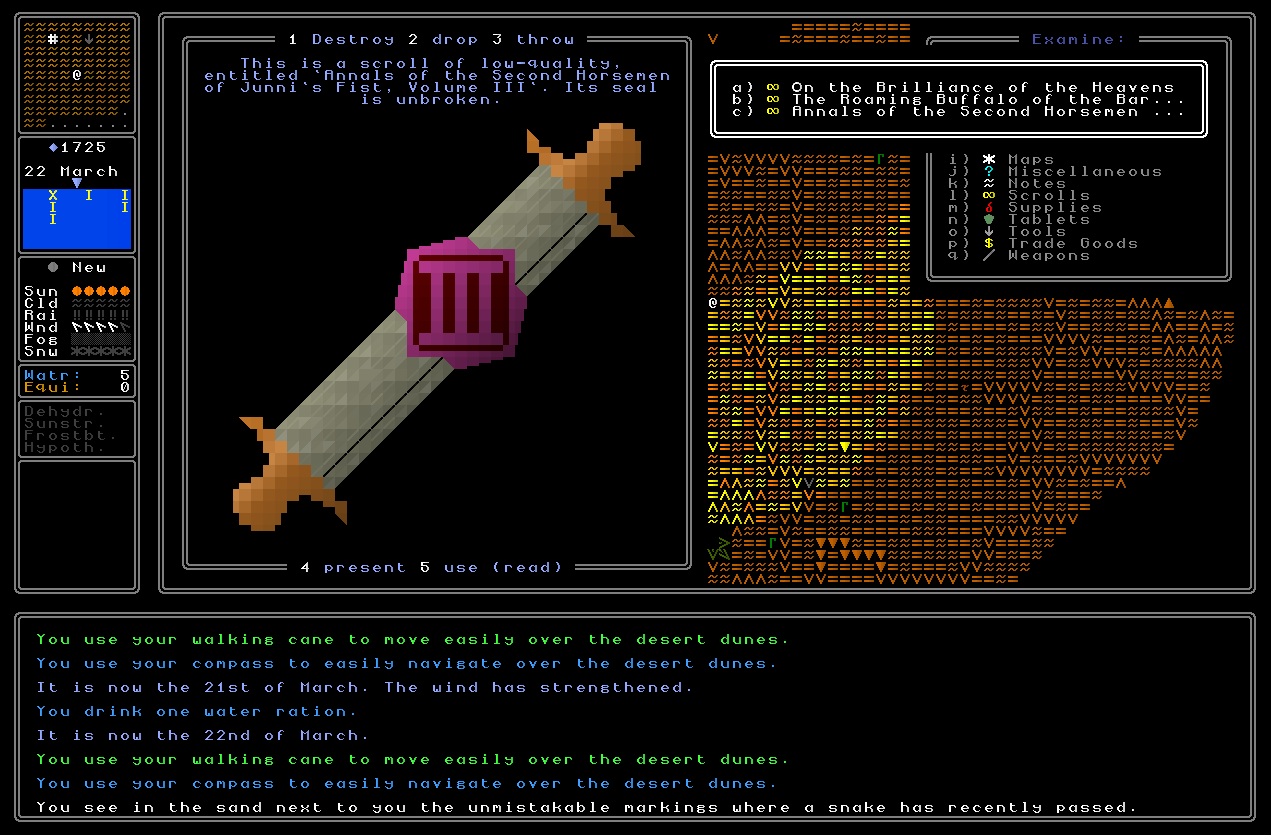
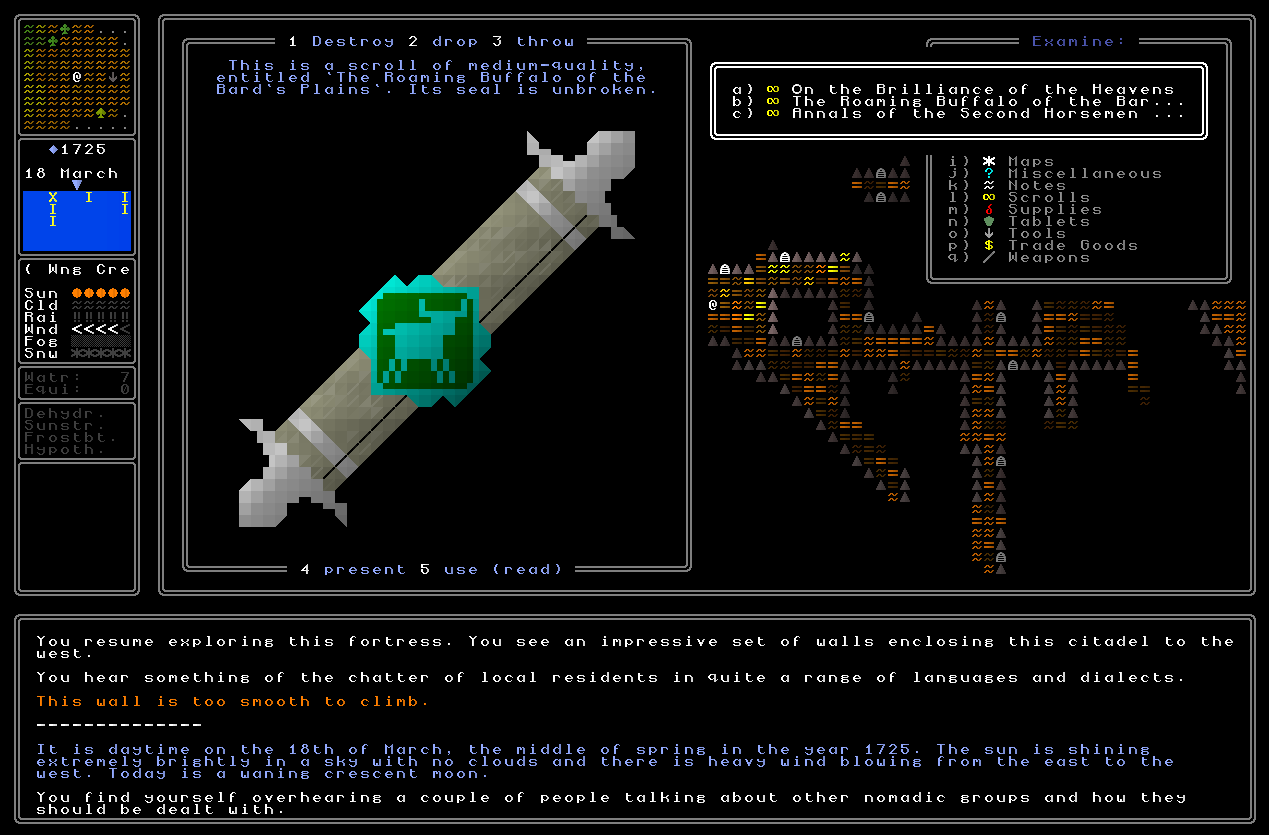
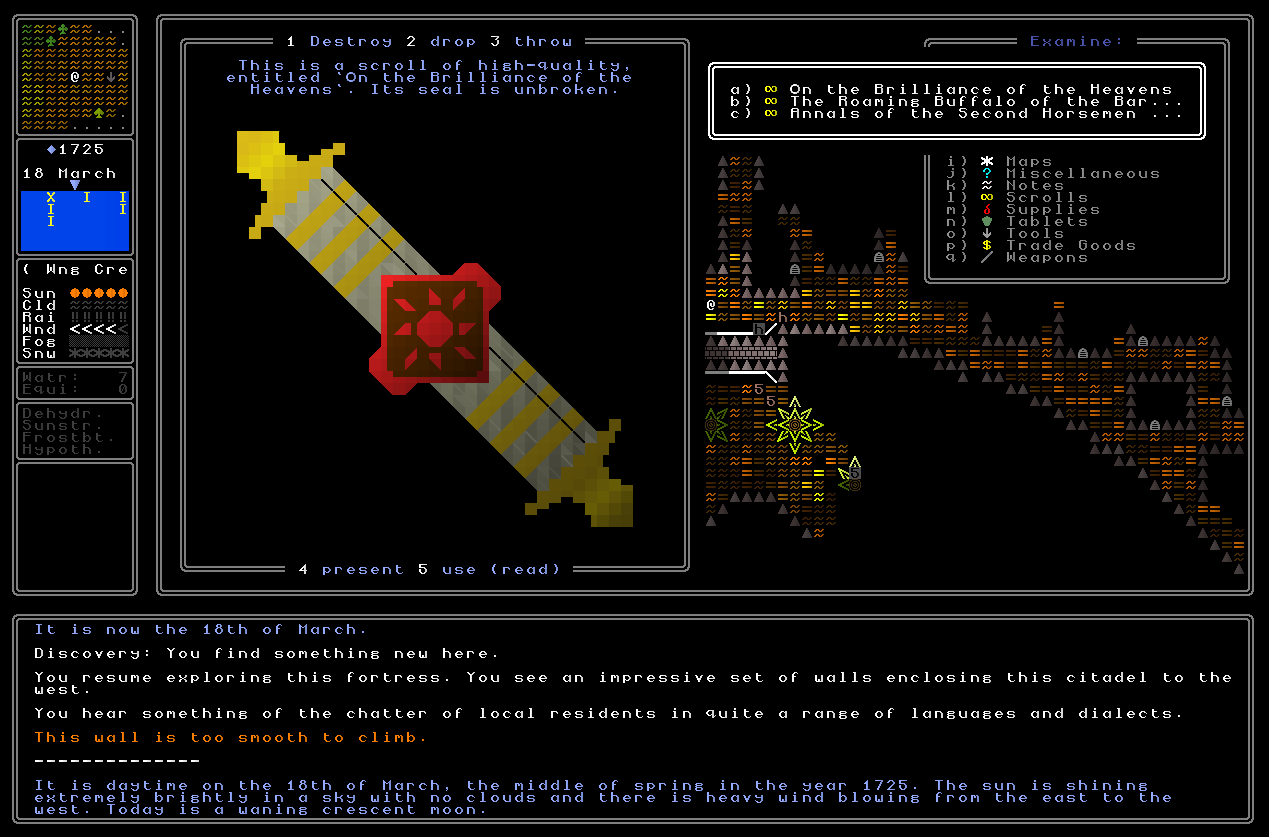
Aren’t they nice?? You’ll also notice that the seal always reflects, very closely, the nature of the scroll in question. Whereas books have generated covers with goodness-knows how many permutations (well into the hundreds of millions), scrolls only have the seal to convey some kind of visual information about the content, and so I’m working on a huge suite of relevant symbols to slap on the seal (which are also going to have value elsewhere, but we’ll come back to that in a later blog post some time). There are going to be hundreds of possible seals, anyway, to usefully reflect everything that you might find in scrolls. You can also see some of the potential names for scroll texts here – this generator is not finished yet, but I’ll do a proper update on these once these are done. As with books you’ll be able to find scroll sellers in nomadic fortresses, and also of course as loot from chests, buried in hidden places, and so on and so forth.
Now you’ll notice that not just do these all have seals on them, but in each case the seal is described as unbroken. This is – generally – how you’d find a scroll, and this means nobody has read the content inside yet, and thus the scroll might be sold as a trade item. If you open the seal to read the content inside, or you find a scroll whose seal has already been broken (this seems like a potentially interesting loot variation), it will instead show like this, instead – with of course the length of the scroll extending also being randomly generated, and ditto the side of the scroll (note also three other scroll titles here) from which it extends:
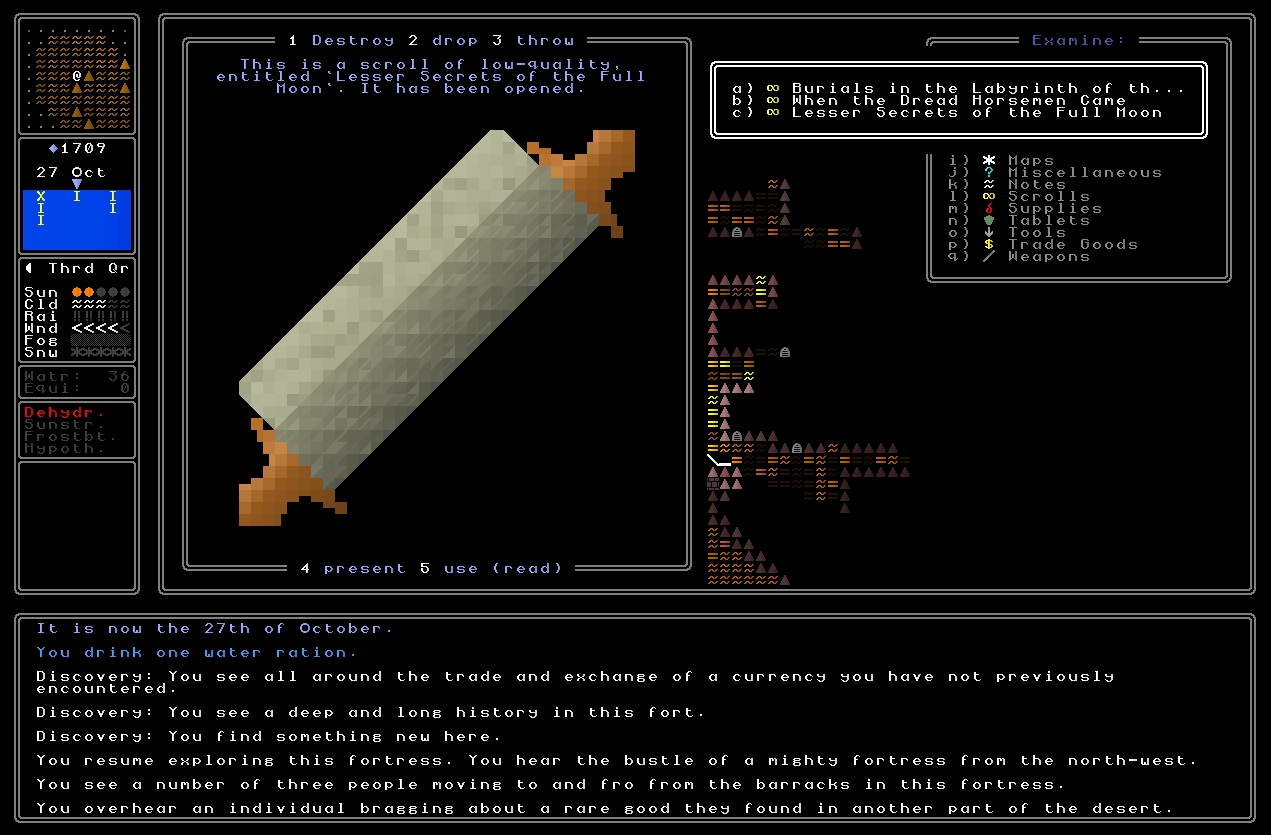
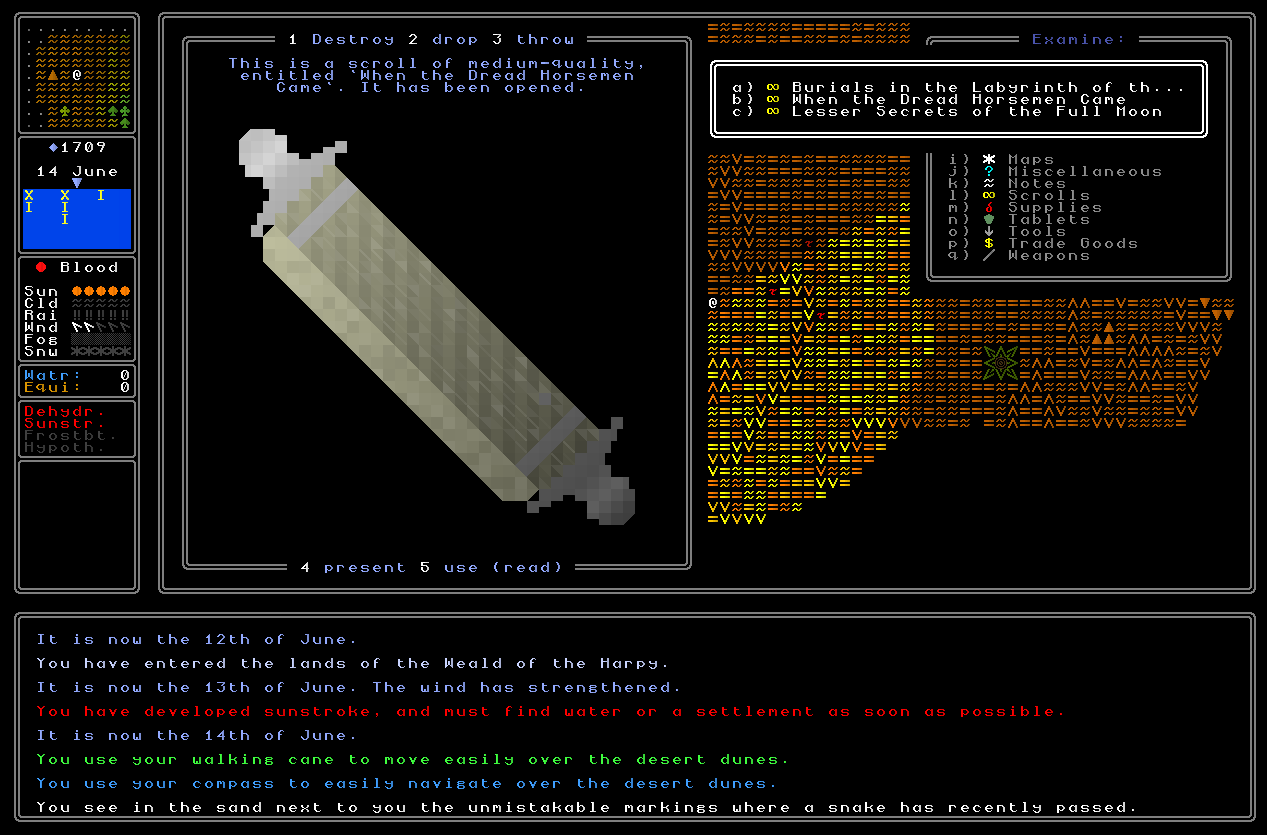
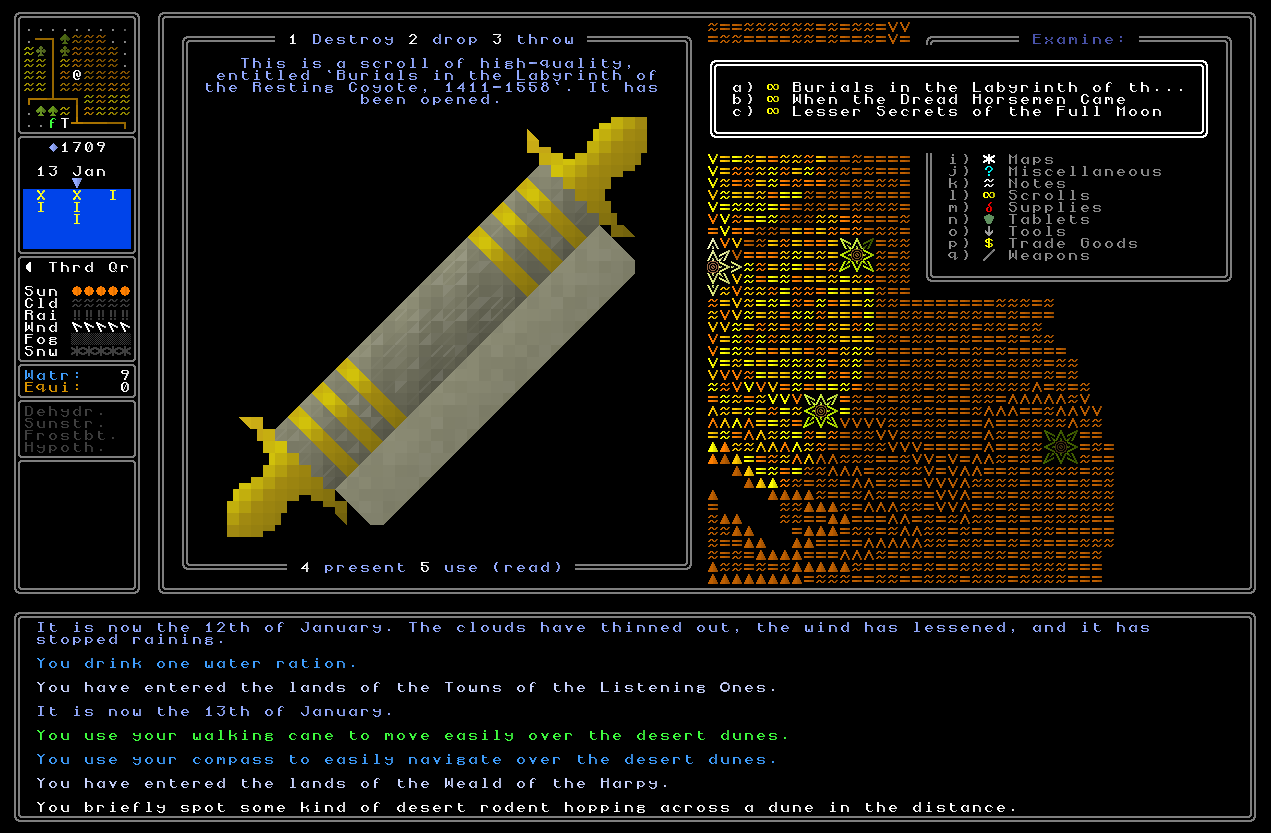
So the idea here is that an unbroken seal enables you to sell the scroll as a trade item – but without learning whatever information it might contain – whereas a broken seal gives you access to the information within the scroll, but it will then be reset to having zero trade value. Traders will refuse to purchase a scroll with a broken seal, though by the same token they will never sell you those either. This is to stop players doing quite a tedious but optimal potential gameplay method that came to be while designing scrolls (and also applies to books) – buy a book, open it, use print screen to record everything, and then sell it. I have no issue with people taking notes outside the game, although I do intend to add maximum facility for taking notes in-game, but that just seems like a tedious and dull things to encourage players to do, even if it would be the optimal playstyle. As such, to reduce the inclination to do that, using a scroll for information destroys its trade value, so there’s no reason to not just keep an opened scroll in your inventory, without using print screen on your computer to record its data. For the same reason, books will also gain seals (though I’ll probably call them “clasps” or something) in the near future to achieve the same goal – an unopened and therefore unread book is a trade item, an opened and therefore read book gives you information, but cannot be used as a trade item. I think this is quite a neat solution, actually, and should again yield some interesting decisions – do I need to open this new book / scroll I’ve found, or do I sell it? If I sell it, where should I sell it, and to whom? Or can I not make that decision yet, and I should hold onto this for now, forgoing both the money and the information, until I know what to do? But what I need that money / info right now? Etc etc. Anyway, I’m super happy with how scrolls look! Although, as long term readers will know, I have started to design book pages for when book content generation comes fully into being…
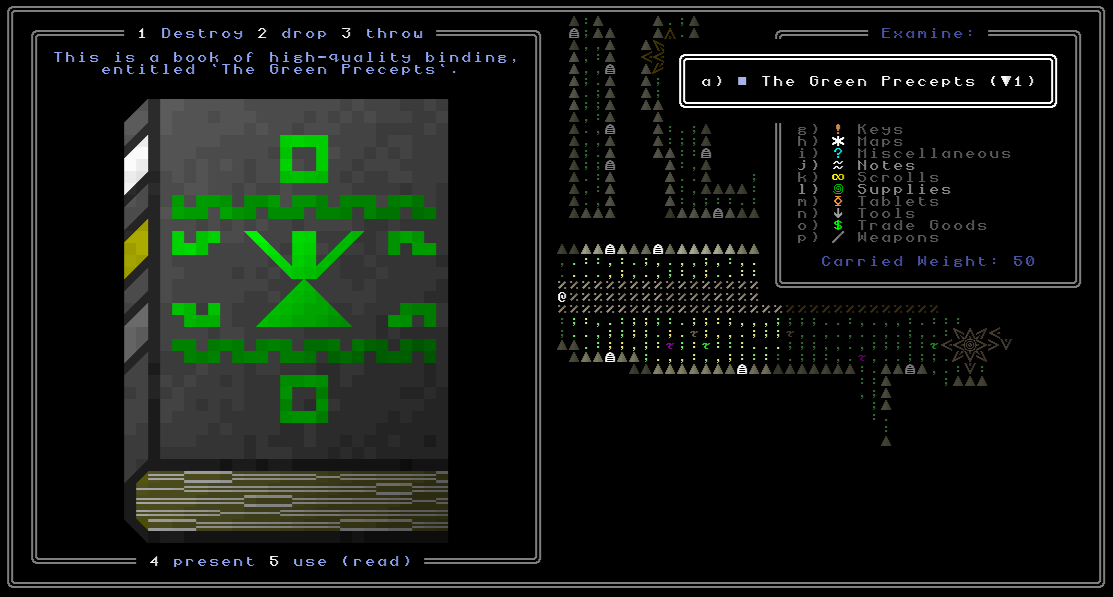
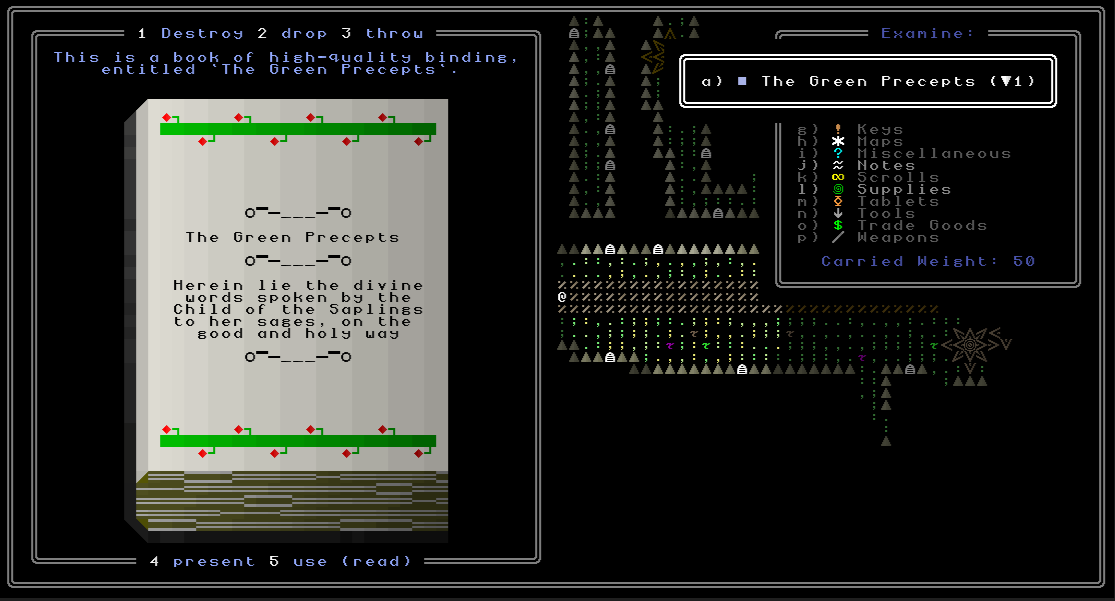
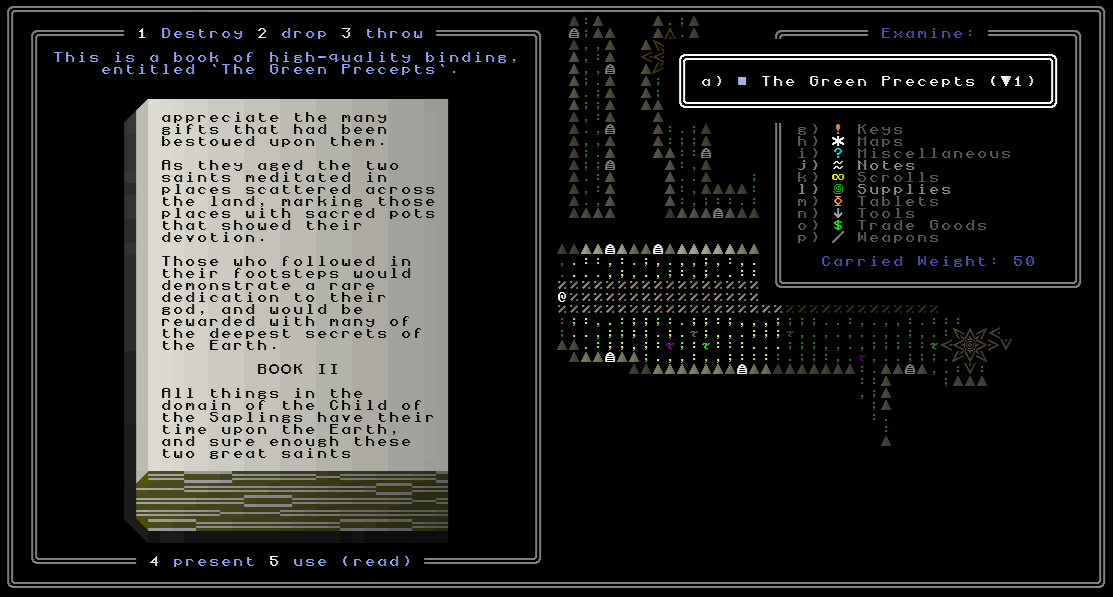
…I haven’t yet done the same for scrolls, though I’m sure we can all guess what those will look like. That’ll be coming in soon, but for now, there are other things to work on!
Next, we come to tablets. Sedentary / feudal nations have books; nomadic nations have scrolls; and now tribal nations (soon to be renamed to “ancient” nations) have tablets. These are another generator I’m incredibly proud of, and I really love how these came out. Whereas the feudal nations have five potential aesthetic shapes that everything in a given nation will echo (square, circle, diamond, octagon, cross), and nomadic nations have all of those plus a bunch extra (hexagon, pentagon, triangle, star), the tribal / ancient nations I wanted to change things up with, so they now have four potential shapes – one I’m calling “chevron” (first image), one I’m calling “semicircle” (second image), one I’m calling “pinch” (the third image in these), and one called “heptagon” (pretty self-explanatory). These will, as with the other civilization types, have a huge effect on how everything in those nations look. Anyway, to generate a tablet the game selects the shape in question, adds a texture according to the quality of the tablet – and for high-quality tablet, adds a little painted border, as well – and then adds the text, but translated into the language of that nation. Here’s how they look!
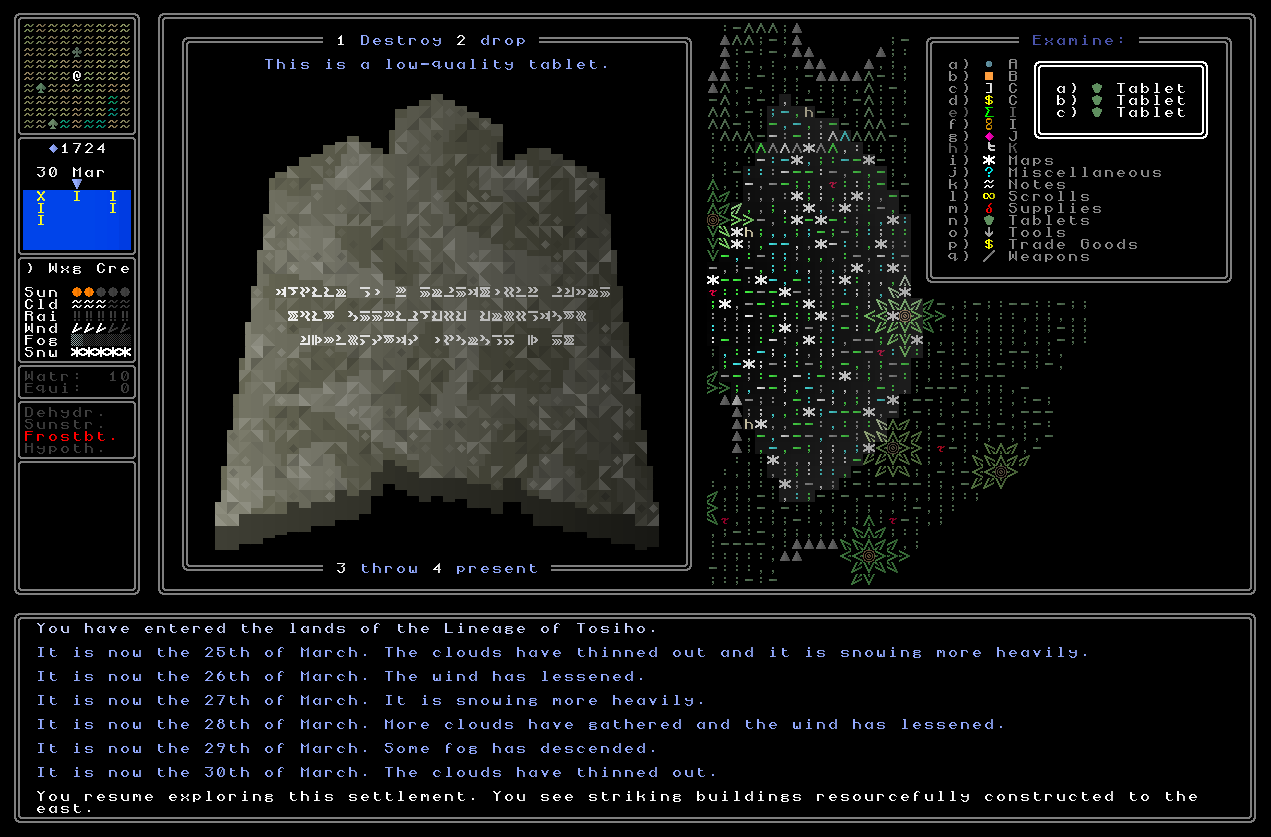
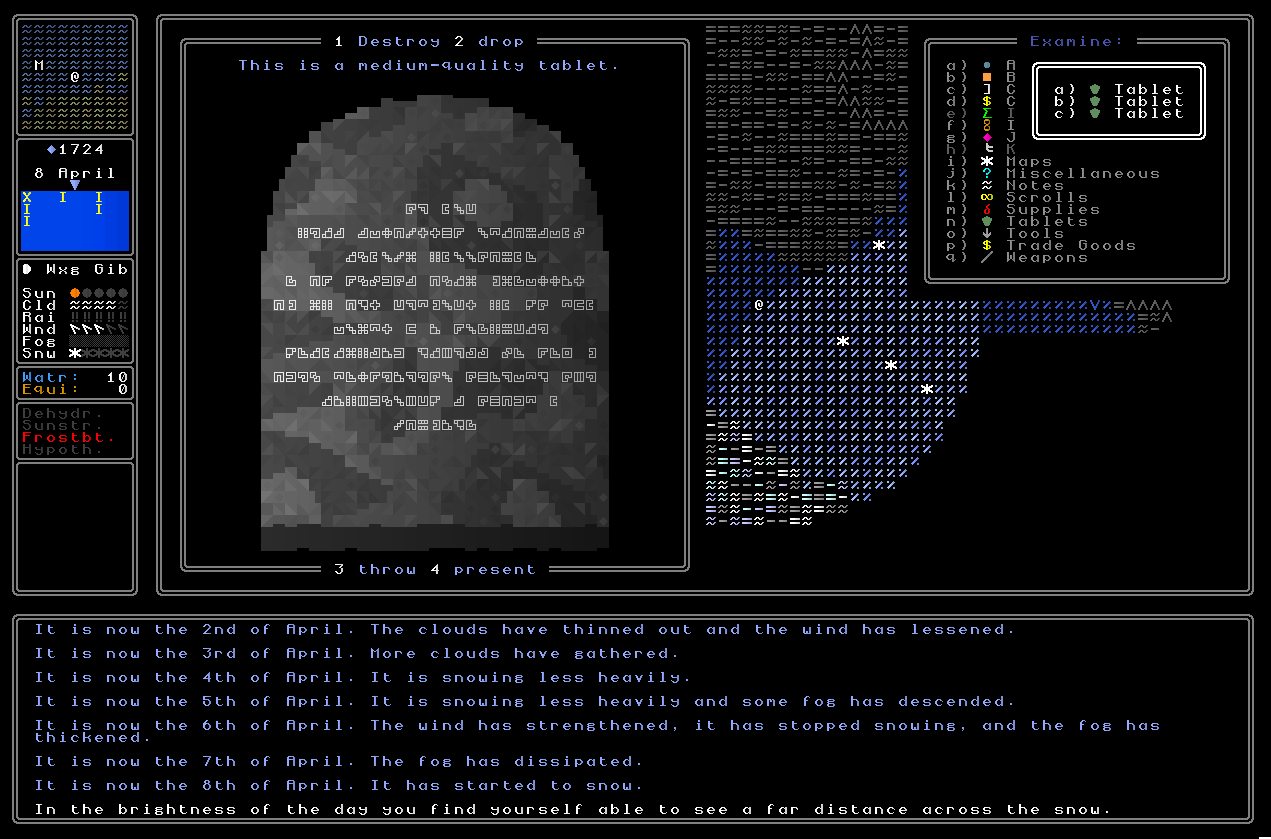
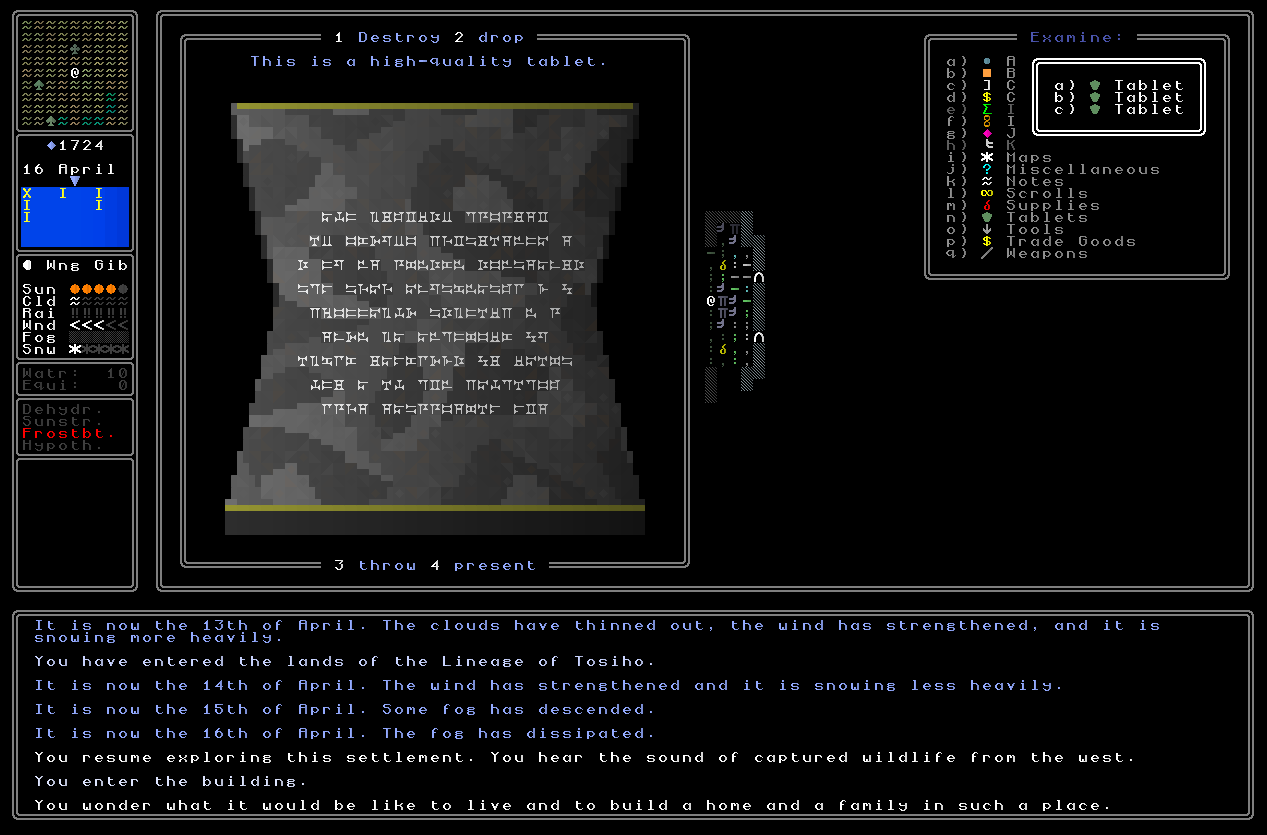
Of particular note here are the low-quality tablets, which have a lot of damage on them. The damage is also, I feel compelled to note, procedurally generated, and my god this was a demanding thing to create, while also of course ensuring that the 3D-ness of the tablet (i.e. the darker parts at the bottom of a tablet showing the tablet’s depth) were consistent regardless of what kind of damage was added, and ensuring damage could be added in as many logical places as possible, while also making sure damage couldn’t be added to obscure a word (I do intend to add this later, but that’ll actually be a separate system, as that system needs to understand what words are being obscured and whether or not they can be safely obscured), was… COMPLICATED. Nevertheless, it got done, and I really love the damage effects that the low-quality tablets can have applied, and there are well over a hundred thousand total permutations for tablet-damage which can be applied there – which is on top of the general tablet variations, so there are certainly hundreds of millions of the things that might, in total, appear in the game (full marks if you ever send me a screenshot with a million tablets in your inventory).
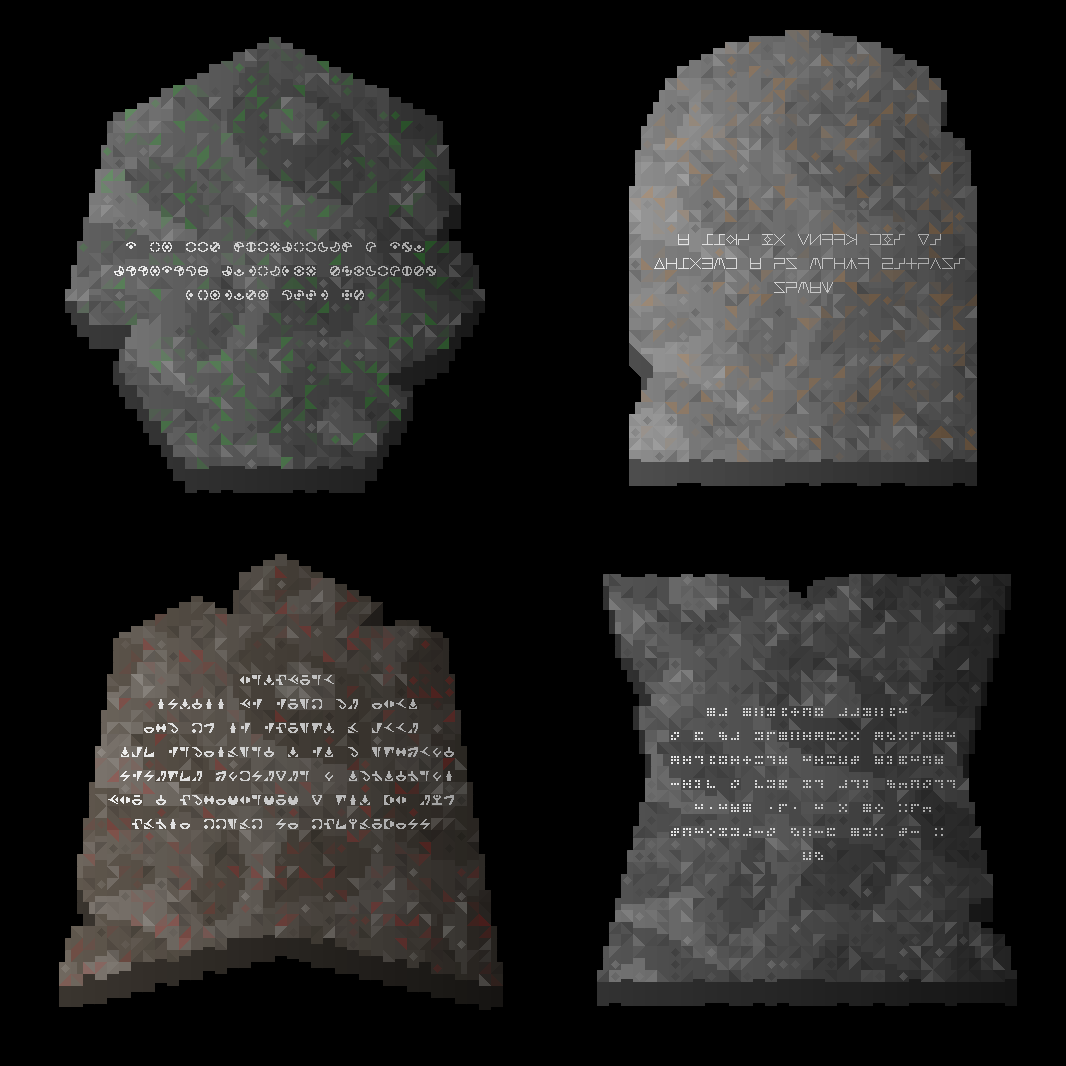
There are a range of nice colour variations for the tablets too, while the rim colour for the high-quality tablets will be the same main colour that the tribal / ancient nation uses on its flag, clothing, etc. Another ultra-complicated aspect of these was making sure the text can be centered. The text is procedurally generated, of course, and then it needs to be centered, which seems easy enough until you consider the fact that we don’t know what the text will be before it’s generated, we don’t know how many long words and short words it contains (hence how smoothly it can be put into lines), the shapes of the tablets can be strange and non-symmetrical when you go up and down on the tablet from the middle, and we need to accommodate damage as well. Again, this turned into a remarkably complex piece of code which calculates first what the middle line of the text is, and then puts that in the middle, and then puts the remaining lines going up and down from that middle line, while keeping within the confines of the tablet, and does so while trying very hard to ensure that the whole thing overall looks like it’s pretty well “centered” on the tablet. It’s a tough one again, but very happy with how it came out.
Lastly, let’s talk a little more here about the languages. Firstly, these are not substitution ciphers, as those (in English at least – I don’t know about other languages?) are trivial to solve even without a key, let alone with a key. The way the system is going to work is that each word in English will have a random selection of symbols chosen to represent that word, which might be as long as that word, or longer, but will never be shorter (you’ll see why in a moment). So, for instance, “The” might become “%&*” or “!$%” or whatever, and might become “:&&%” or “$!$%*”, but cannot become “%&” or something like that. The reason for this is how the translation system is going to work – as you gain knowledge of one of the tribal / ancient languages / scripts, you’ll be able to press tab when you’re in a conversation, or looking at a tablet, or anything else which contains their script, in order to apply all your current translations on top of what’s there, to get a sense of what is being said! This will probably be done with the tab key, and doing this will also show the level of certainty you’ve assigned to each translation – green meaning “I’m confident”, yellow meaning “maybe” and red meaning “possible”. This of course also means we need to work on a hefty dictionary-type function for each of these scripts, but this game is nothing if not ambitious (is this noticeable?? I’m not sure), but here’s a mockup of how, roughly, a given tablet might look with the “show me my current translations” applied – and this time in a heptagon shape, just to show that one off:
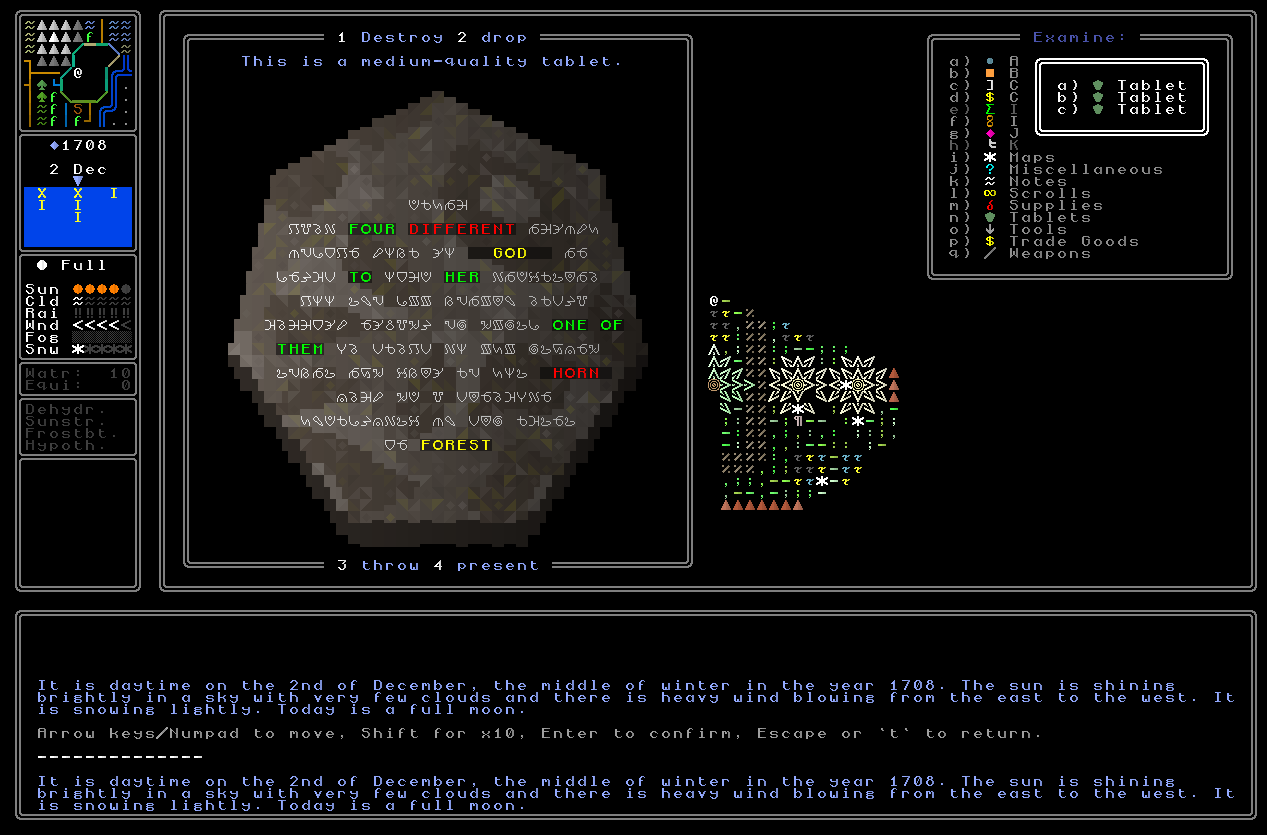
I think this is really exciting, and a novel way to handle invented scripts! (And in this example, maybe one would start to think “GOD” was a wrong translation, and it might be “GODDESS” instead…? I’m excited to see these decipherments coming into being through all these kinds of contextual clues in speech, tablets, other places one might find tribal / ancient writing, etc…). Notice also how “GOD” and “HORN” guesses are smaller than their word – this is indeed totally valid, but it can’t be the other way around, otherwise the real words couldn’t fit! I stress, this is just a mockup for now, but we’ll have more on this in the future once I come back to really working on the tribal / ancient nations and transforming them into something full and interesting (not 0.11, but maybe 0.12?).
Also, re: the seals and clasps, you’ll notice that everything I said above about books and scrolls doesn’t apply to tablets, as I can’t think of any way for you to “open” them in a similar way – as such, tablets will simply never have any trade value. One might think that seems slightly strange from a flavour point of view – surely collectors of antiquities and intriguing goods from far-off lands would like them – but the in-universe explanation is going to be that traders and the like have no interest in something whose language cannot be read, and thus they are just considered to be useless hunks of stone and rock with some baffling scribbles on them. Again, this’ll prevent people from needing to take screenshots and then sell tablets, rather than just keeping tablets in their inventory. And, of course, given the translation mechanics, tablets are much more active items than scrolls and books – as your understanding might change! – so that’s another good reason to make sure the player keeps them in the inventory, rather than taking screenshots and selling them. So there we have scrolls and tablets: I’m super happy with how they’ve both come out, and I’m excited to develop them further!
Next, I have also added a new and quite rare and high-value trade good – dyes. These appear in textile shops (and like everything else might appear in general stores, etc). It’s comparatively rare that I get to use all these sorts of vibrant colours for real-world items in this game, but this is a great example of where this is possible. These are pretty expensive but will generally fetch a high price in distant locations. As well as the items themselves, all the relevant data has been added, and they spawn, can be acquired, can be sold, have a price, weight, size, all these sorts of things. And of course, as with all items they might be used in a clue – perhaps if one is told to place “miserable dust” somewhere, a “blue” (!) dye would be the thing to put down? Anyway, I’m happy with this generator and how they came out in the end, even if it was actually one that wound up requiring a surprising amount of effort – “organic”-looking surfaces, like something which is essentially a pile of dust, is much much harder to convincingly generate than more manufactured surfaces (this will be a challenge once we come to wildlife, but let’s cross that bridge when we come to it).
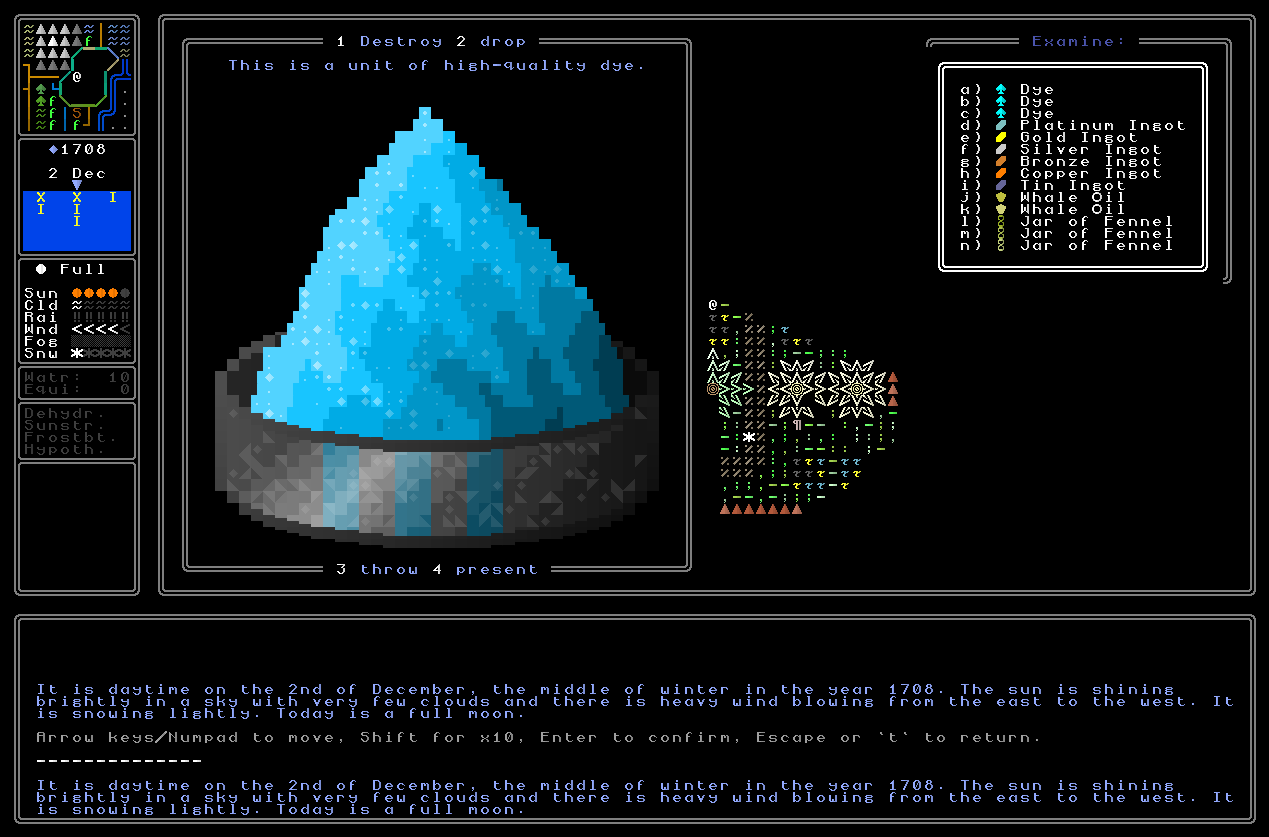
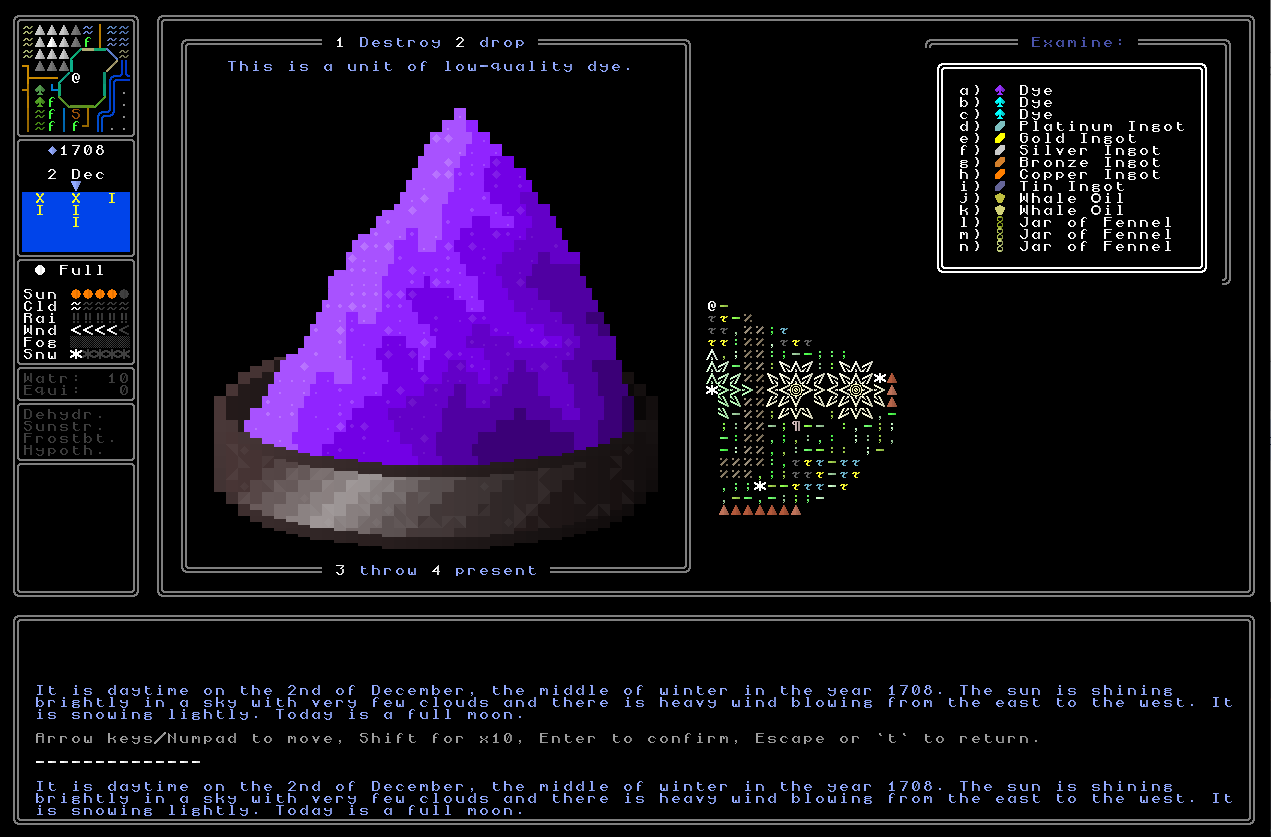
Next, I have added another religious relic permutation – marbles! I’m not quite sure how I settled on this idea for a relic, but once I had it in my head – and had a good sense of what the generator might look like, and how the thing would work – I couldn’t shake it, so I had to make it. I think this is a really fun one and, again, I love how the generator has come out. These relics are produced with names like “The Sacred Marble of the Glass Sepulcher” or “The Blessed Marble of the Clear Vision” and are currently in the all religions relic pool for potential selection and generation (rather than the animal god pool, the Lovecraftian god pool, the demonic god pool, or the pantheon pool). The generator came out very nicely, I think, and I like (much like dyes) how these give me a(nother) good opportunity to use colour palettes that one doesn’t ordinarily get to use all that much in the game. All relic types have a maximum number, as longer-term readers will recall, and as there are eleven central patterns I made and eleven colour palettes, that means that a religion which chooses this relic type has a maximum of eleven relics that might be scattered across the world – and, as ever, each relic type will have a significant effect on the content of their holy book as well, but we’ll get to that when we get to that…
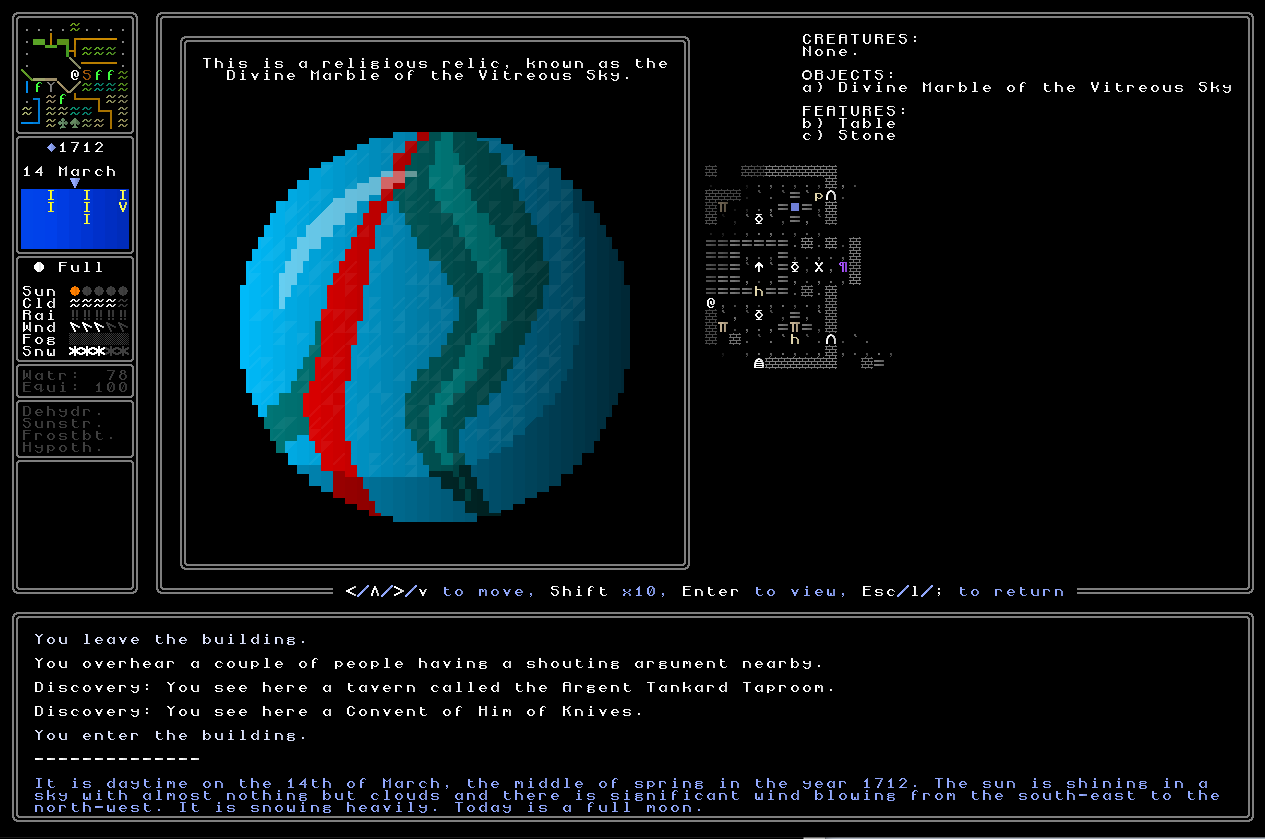
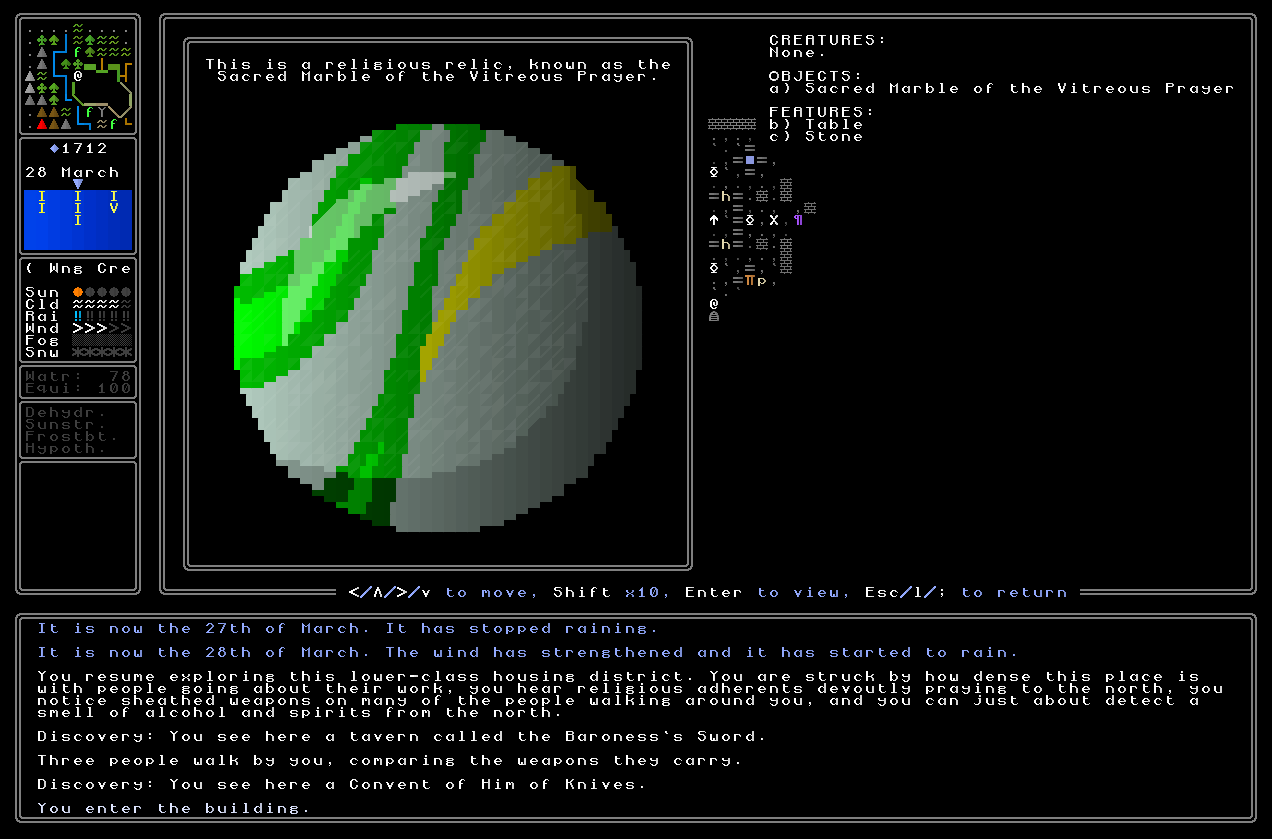
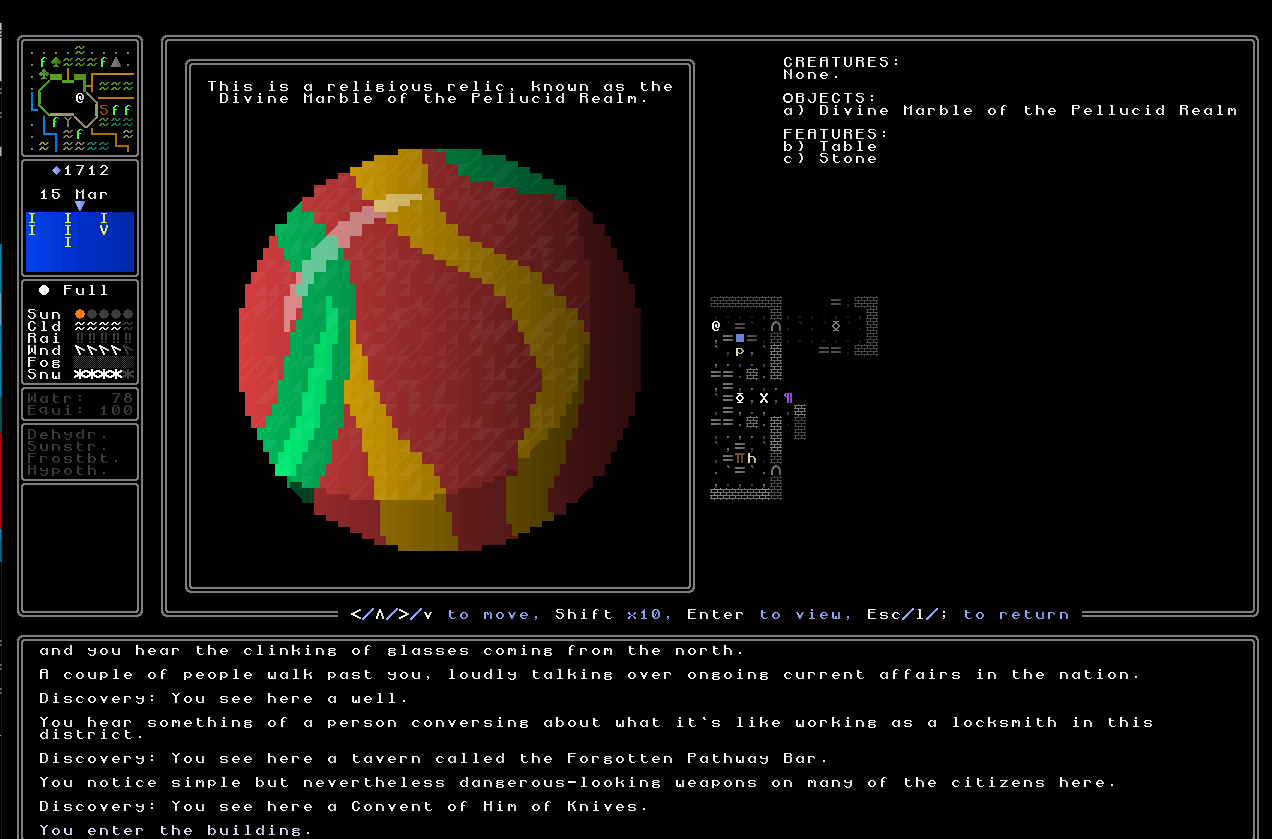
Finally, I also this week found a strange, strange item in my travels. While all the other items I found at the same time made total sense to me, this one was a little baffling by comparison. It doesn’t seem to have any obvious function, and although I’m sure if I threw it, it would shatter upon impact with anything, that doesn’t seem to be the most optimal use I could put this thing to.
I wonder what it’s for?
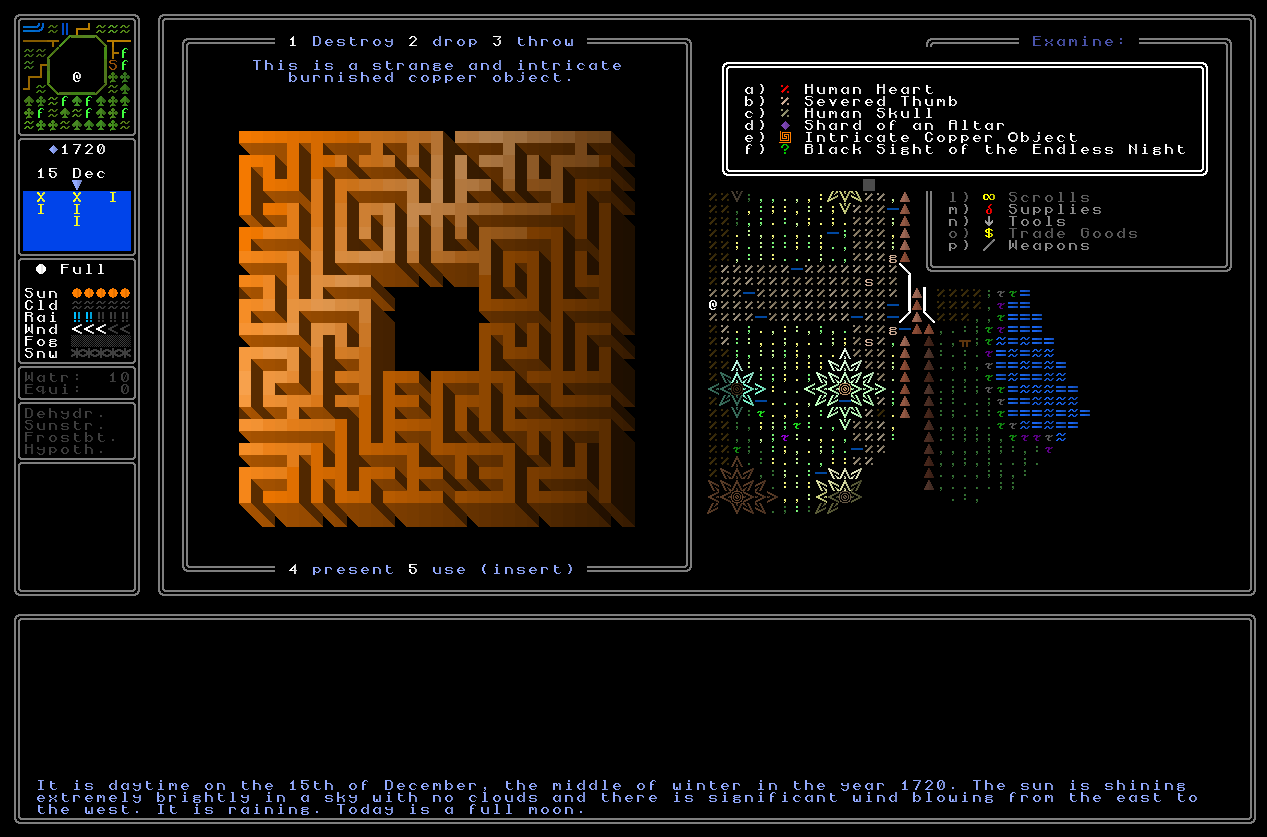
Very weird. I also recently discovered that strange sphinx-house, yet this seems to be a very different kind of thing, perhaps related to a different faction or perhaps some strange kind of technology? It’s all extremely odd, either way, and I’ll have to keep my eyes peeled for anything I might be able to do with such a peculiar copper thing…
What next?
And with that, I think we’re pretty much done for this week! Thank you all SO MUCH again for reading and checking out the blog, I really do appreciate it, and seeing such solid reader numbers on the website tracking each week honestly does a great deal to keep me excited and motivated to develop the game :). It’s also, of course, very exciting that finally (yes, 13 years…) the pieces that will contribute to generating the core mysteries, the core riddles, and very open-ended objectives and quests from major in-game factions (religions so far, nations to follow), are at last beginning to fall into place. I’m still keeping the tri-weekly update schedule, so as this post is being published on July 21st, you can expect the next post on August 11th!
Thanks so much for reading, everyone – as ever, please do share with any other roguelikers who you think might be interested, please do let me know your thoughts on all this in the comments (urgh, I sound like a YouTuber here, don’t I?), and I’ll see you all in 3 weeks! 🙂
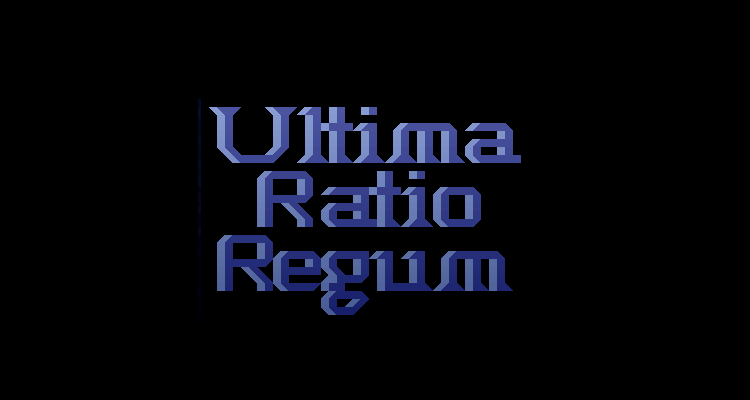
I’m pretty sure substitution cyphers are pretty simple to crack for languages using alphabets. Maybe slightly harder with bigger alphabets, but not by much. It might be a different story with languages that use other writing systems, like Chinese or Japanese, but I know very little about them.
Anyway, this is a great writeup as always! Every time I read one of your blog posts, I’m tempted to take a stab at something similar… But I think I will content myself with playing URR!
But maybe some day…
Thanks so much for the comment, KarbonKitty! As you say, way too easy to crack on alphabetical languages, so I’ve moved away from those very much (I’m reminded of when I just deciphered the Environmental Station Alpha one in a spare moment, before THEN discovering the game actually gave you a key later on! Whoops). Anyway, I’m so glad you enjoyed the blog post, and if you ever do embark on your own mega-project, do let me know. The standard advice is always to start small, but I think we need as many mad, vast, grand, projects, as possible :).
The system you discussed in the last update about advancing in religions by fulfilling their requests is really coming together, with the altar shards and those wonderfully gruesome trophies! The hearts look particularly good. For the altar shards: if you’re looking for more items that a religion might want you to obtain, consider how altars in Catholic churches usually have relics inside of them. Perhaps in addition to shards, smashing an altar apart in URR might reveal relics (marbles? statues? the finger-bone of a saint? etc) inside. It’s also amusing how in the current version people in a religious building won’t get mad if you walk in and smash up the altar in front of them…I suppose if you’re wearing a hardhat, reflective vest, and carrying a clipboard, you really *can* get away with anything!
The stone tablets look fantastic and 3-dimensional (they immediately made me think of this scene from History of the World: https://www.youtube.com/watch?v=4wunGF3oMA0 ). I particularly like the color-coded overlay system for translating the writing — I think that this will make players feel like actual archaeologists (archaeo-linguists?) as they puzzle out the meaning of a tablet. It reminds me of the Inkle game “Heaven’s Vault” — have you played it? You also mentioned an in-game dictionary function for the translations; I assume it will auto-update as your character confirms translations for words, but it might be interesting if the player could manually update the dictionary with suspected translations for words that the character is uncertain about (i.e., the yellow- and red-coded words).
The buttons and wax scroll seals are both interesting from a game design perspective. They’re practical compromises for gameplay elements that you want to include in URR, but their underlying assumptions (that defeated enemies give you a button, and that scrolls are only salable when sealed) are specific to culture of the URR world(s). I don’t think players will mind this compromise at all, provided that it’s somehow made clear that the assumptions are cross-cultural values in the game. For example, a scroll/book merchant might explain the seal system to you when you ask him about scrolls, and likewise about buttons from a collector. It might seem that nobody wants to buy a scroll if the seal is broken, but if it’s made clear in the game that that’s how things work in this culture, players will be onboard with it from a ludonarrative perspective. It might also make sense to have book clasps sealed with wax the same way as scrolls are, just to simplify things for the player (…and the developer).
On dyes: I hadn’t thought of dyes as a trade good, but in an odd coincidence I first started playing Horizon: Forbidden West a couple of days ago and one of the items that you can collect in-game are various plant dyes that can be sold later. Forbidden West cost over 200 million USD to develop (and I’m enjoying it a lot), but the dyes in URR look much better! The generated marbles look beautiful, too…I am interested to discover how they tie into the various cultures, religions, etc in URR.
Finally, that mysterious object at the end…at first, I though it might be a map to a maze, but now I’m thinking perhaps it is some sort of key? Intriguing!
Crowbar, as ever, you set the bar (…) for comments – thanks so much :). I like the idea of sometimes having relics hidden in other places – at the moment they mostly appear in religious buildings and monasteries, but also rarely in secret locations, or in treasures, or “lost”… but we know that PCG is always at its best when we maximize permutations and their impact, so having a rare relic hidden inside an altar is an awesome idea.
Re: tablets, hahaha, excellent reference – and I hope so too! I haven’t played Heaven’s Vault, but it’s on my list. I recently finished playing Tunic and that had some serious language-decoding aspects, so I’m taking it easy before I give another one of those a shot (as much as I love them). Yes, indeed, it’ll auto-update with everything you learn from books or from other people, but also, yep, you can put in guesses / estimates as well, which as you say, will be the yellow / red ones (or green ones if you’re super certain, but that might be ambitious). You’re also totally right of course about the assumptions being specific to the URR world, you’re totally right these will need to be made super explicit. Probably the first time you open a book / scroll it’ll give a one-off warning. I think also having merchants explain it to you the first time you meet them in a given game world is an awesome idea too – that would be a very easy one-off little script to add to merchant conversation. And book clasps – yes! I’ll be adding those to the visuals soon.
Hahaha, I’m so glad you like the dyes! I’m still debating going back to the first HZD, though I haven’t yet. Still might though. Glad you like the marbles too, I’m looking forward to working on holy books and the like, and ensuring that each relic integrates logically into each cosmology. And maybe into that religion’s secrets, too…
And – 🙂
Hi Mark!
Amazing update as always, I always love to see the varied generations of objects. It’s crazy the amount of depth that’s going to applied to each nation down to each individual NPC we meet.
One thing I was wondering (Forgive me if this may have been mentioned already) was the possibility of random gen alchemical agents. I know flora is already generated but maybe tinctures and tonics that are created by combining certain reagents could come into play?
Then again, I don’t know if that’s sliding to far into the fantasy side of things?
Looking forward to the coming updates!
Kyle
Thank you so much Kyle! I really appreciate it a lot. Re: alchemical agents… well… you might have slightly anticipated something being worked on at the moment. We do have all these plants, after all, and fungi will appear at some point soon, and one could imagine not just picking particular things but also maybe the phase of the moon matters, or the bioregion matters, or the time of day matters, and…
Yeah – more on this in the future! (And there are, after all, plenty of plants and fungi in the real world which can have profound physical and mental effects, so why not in the URRniverse? I don’t mind adding things that don’t necessarily exist IRL, *as long as* things are physically possible…)
Hi Mark!
That’s good to know!
Apologies for spoiling anything if this was planned as a big reveal. I may spend a great deal of time creating my own alchemy lab, perhaps basing myself out an an abandoned ruin somewhere and collecting herbs and fungi from around the region and documenting their effects.
I wonder if this would be something the player would need to manually note down or if the game would automatically create a recipe that you could refer back to? Personally I’d like the idea a having a tattered leather-bound book kept in the corner of the lab which contain my scribblings of experiments and outcomes amongst the various tomes I’ve acquired from travelling the lands.
The main quest may fall to the wayside for me, (Which I believe you’ve mentioned is currently in flux anyway). I’m now an alchemist hermit in the woods who is very protective of their shack! You may not understand the diagrams that are scrawled on my walls but it’s actually an intricate map detailing the harmony of the elements!
Bonus points if I spawn in a civ that values and worships elements! This could also include the four bodily humours! Blood, Yellow Bile, Black Bile & Phlegm. I don’t know if that could be subject to randomisation as well as I suppose we’re limited by bodily secretions (Apologies if you’re eating whilst reading this)
Zork Nemesis has always been a childhood favourite of mine which references heavily on alchemy and astrology. (I believe I recall URR generates astrological patterns?) so this being a possibility in game really sounds amazing.
Thanks for continuing to work on URR, I’m amazed at the amount of depth that’s taking place here. One single generated world will contain enough to keep people encapsulated for a very long time.
Just a final question, I hope you don’t mind me asking but it’s something I was curious about but what is your official stance on modding? I’m a little hesitant to ask and I don’t want to appear rude by suggesting that the game *needs* to be modded but I was something I was curious about.
All the best & hope you’re well!
Kyle
Hi Kyle, haha, not at all – and besides, only the true elite followers are going to be reading the comments, so it won’t be a spoiler for many people ;). As for notes and recipes and so on, again, that’s a future update as well – probably the update after next, as the next update is now scheduled but the one after that will be one of two things. So yes, in the near future, more on this will appear…
As for generating stars and such, I am working on that though still debating what the precise integration is going to be; I like the idea of being able to stargaze, and connecting generated constellations to some riddles, but I’m not totally sure how it’ll all come together yet. Either way though, again Kyle, thanks so much for the feedback! I genuinely do appreciate it a ton.
And re: modding, my official stance is that I never intend to allow modding, BUT I will always seriously consider fan feedback and implement things I think are cool and fit with the overall tone / direction. So I read every blog reply, every email I get, every comment on Facebook, etc etc, and any which have serious suggestions for ideas I will seriously consider, and implement the ones which are a good fit!
You’ve done quite the impressive job implementing all the minor goods that would make the backbone of a real functioning economy. I really enjoy that it’s not just the religions and win conditions being focused on but also all the other elements in the world.
Hi Jano, thank you so much for the comment! Yes, absolutely – there are some more of these planned actually, since as you say, generally fleshing out the world and boosting the number of “ordinary” items in circulation is really important as well :).